








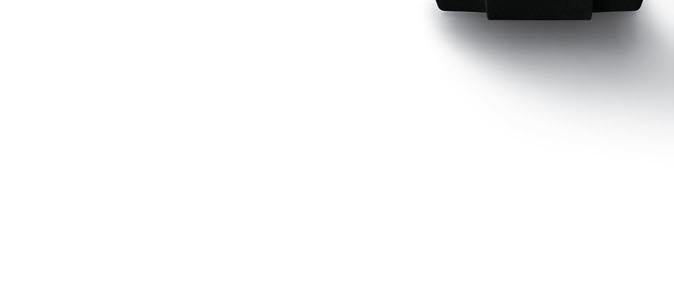













Israel is a fascinating country full of extremes and the cradle of various religions and cultures. It is a mosaic of enchanting landscapes, Biblical sites and modern cities. A country where the multicultural complexity is a daily challenge.

 View from the Mount of Olives of the Jewish cemetery, Jerusalem.
View from the Mount of Olives of the Jewish cemetery, Jerusalem.


Tel Aviv is a vibrant and modern city with an infectious youthful buzz. With its wide beaches, sunny climate, interesting architecture and varied nightlife, this city on the Mediterranean Sea is currently a very popular destination for a city trip. Tel Aviv is a relatively young city. It was founded in 1909 as a Jewish settlement outside the old Arab city of Jaffa. Rothschild Boulevard - a mile-long avenue lined with ancient trees - is like the city's main artery. Here you will find many houses in the Bauhaus style, a minimalist style that emerged in Germany shortly after World War I and which was introduced here by Jewish architects fleeing Nazism. In the period from 1930 to1950, they built a neighbourhood with more than 4,000 houses. The houses are characterised by clean lines, austere frontages and flat roofs. Since 2003, 'The White City' has been on the UNESCO World Heritage List. Tel Aviv is Israel's most liberal city and that is reflected in its nightlife. Just like New York, it is 'a city that never sleeps' with a varied and extensive range of restaurants, bars and clubs. In the big clubs, top DJs such as David Guetta and Dimitri Vegas & Like Mike work the turntables. As you can see, you don't have to go to Ibiza for sun, sea and big party names. Scouting out some culture in the morning, lazing on the beach in the afternoon and diving into the nightlife in the evening: for many people it is the perfect holiday formula.

From the upper Midron Park, we have a spectacular view of the wide coastline connecting Jaffa to Tel Aviv.
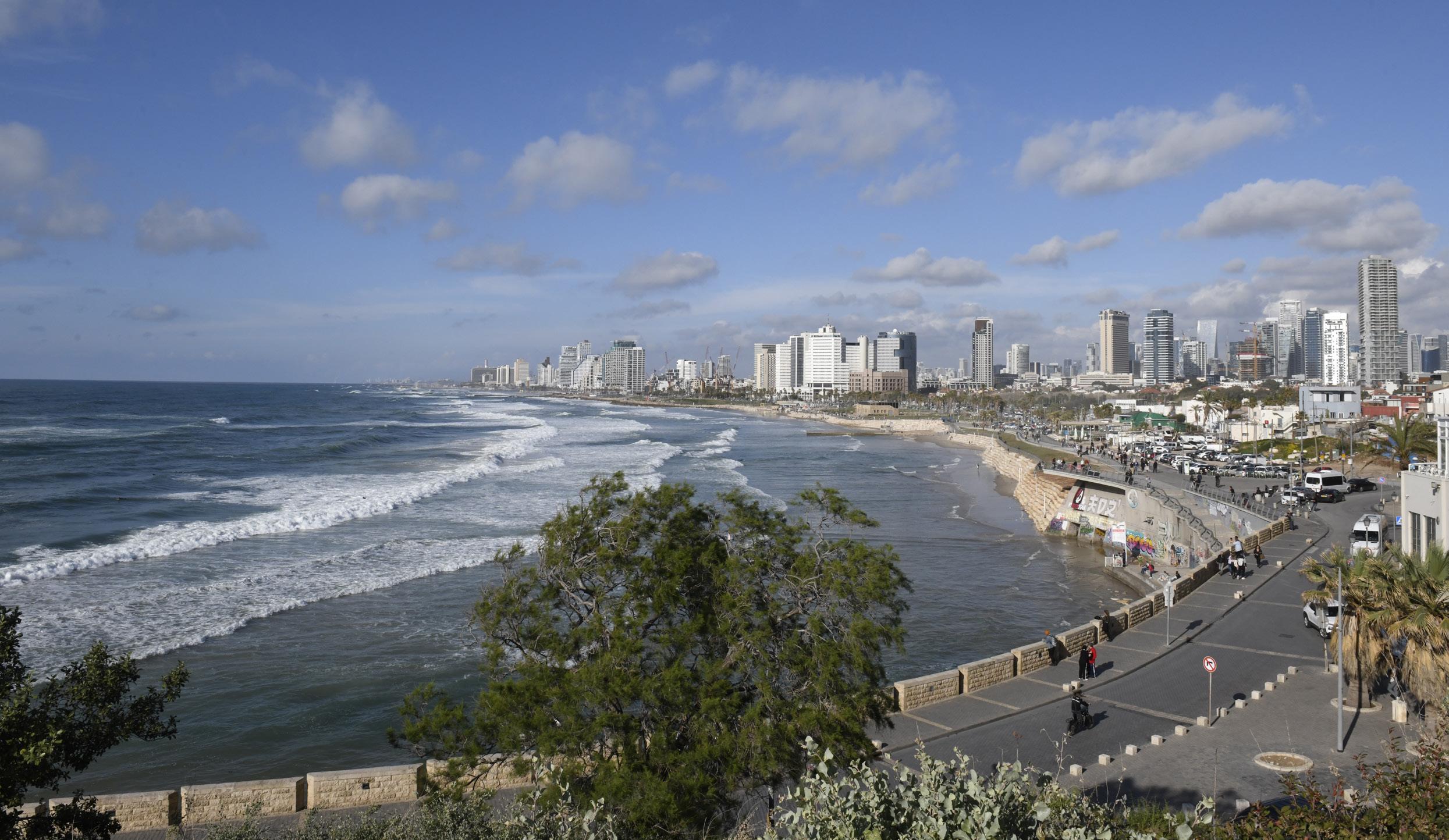
A completely different atmosphere awaits us in Jaffa. Jaffa, situated to the south of Tel Aviv, is picturesque, exotic and scenic. Between the old city walls, narrow alleyways lead to cosy, busy markets where the smell of the briny sea mixes with that of spices and all kinds of local dishes. We can see many Arab influences in the architecture of the sand-coloured houses. Jaffa can look back on an ancient history. It was one of the first seaports in the world and has long been very important for trade between the Middle East and Europe. After the emergence of the ports of Haifa and Ashdod, Jaffa's role as an economic centre dwindled. The old warehouses in the harbour now contain countless restaurants, shops and art studios. From the elevated Midron Park, we have a spectacular view over the broad coastline that connects Jaffa with Tel Aviv.
Panorama from Jaffa on Tel Aviv's long coastline.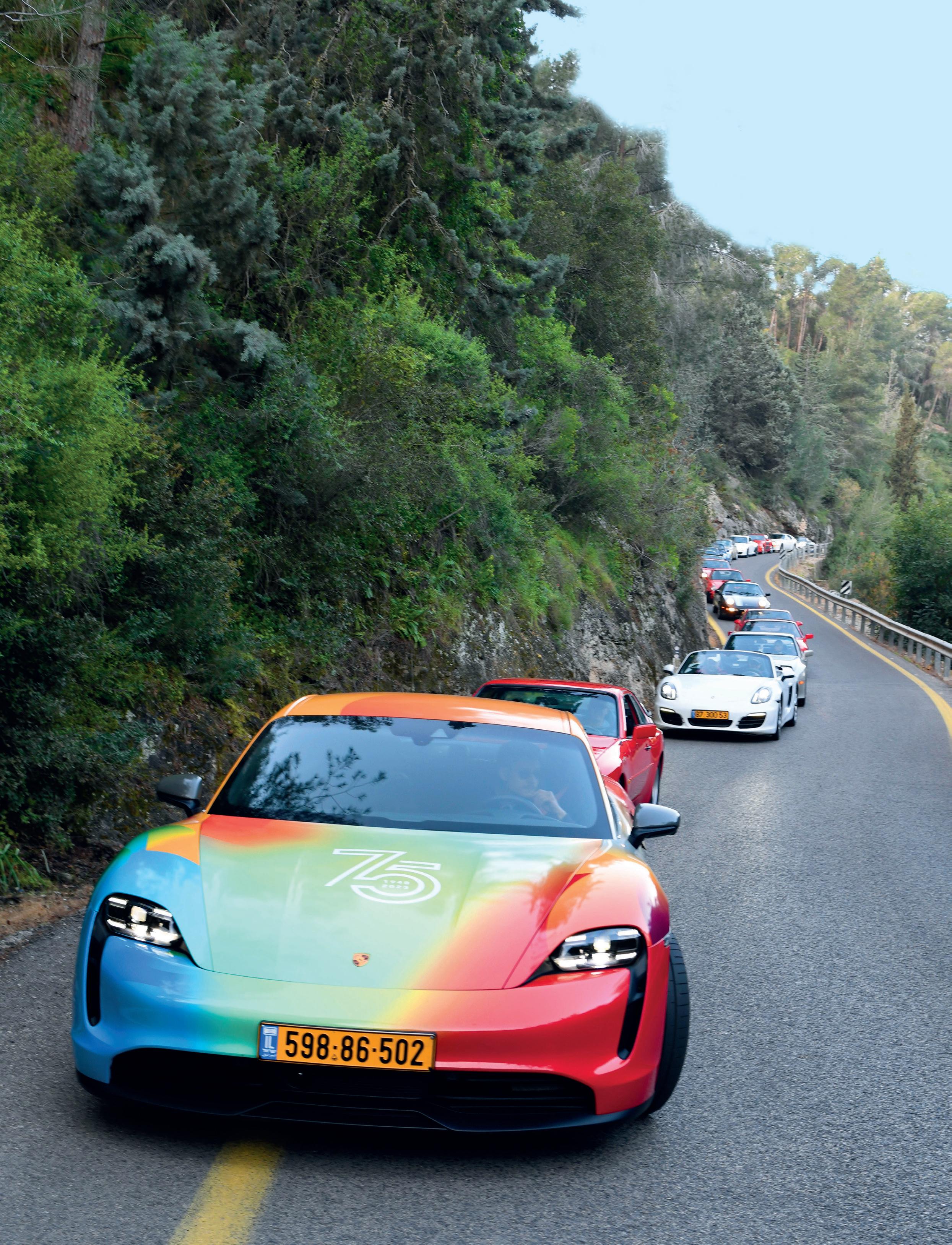



It's five o'clock on Saturday morning. Yaroslav Stepanov - Porsche fanatic in heart and soul and president of the Porsche Classic Club - has just picked us up from our hotel. For Porschist's visit to Israel, he has organised a road trip that will take us through the mountainous landscape between Tel Aviv and Jerusalem. At the assembly point, one Porsche after the other swiftly arrives. At home, Yaroslav has a Porsche 944 Turbo in his garage, but for this special occasion he has been given the showpiece of the Tel Aviv Porsche Centre: a glitzy Taycan in a spectacularly coloured wrap. The international slogan of the Porsche celebration year “Driven by Dreams” is displayed on the side. And today's ride is really a dream. Yaroslav leads the impressive convoy of about 25 Porsches along winding mountain roads past beautiful landscapes. The Porschists put their foot down firmly and can show off their driving skills in the many sharp bends. There's a reason they're all up so early. Now, before dawn, there is no one else on the road and they can feel - if only for a few hours – masters of all they survey.
Around nine o'clock there is a rest stop at a vineyard. Bony is the only vineyard in Israel that is owned by a Christian Arab. The sun is now shining fully. Under a canopy of vines and with a view of an enormous valley, we drink a nice glass of Muscat and eat sesame bread with olive oil, pieces of Brie and a traditional herb dip. The Porschists mingle and tell endless stories. It is clear that this is not just a Porsche club, but a close-knit group of friends. Optimal driving pleasure is not the only reason for the early departure time. Saturday is also Sabbath day and this way, the participants will still have plenty of time after the road trip to spend the rest of the day with family.
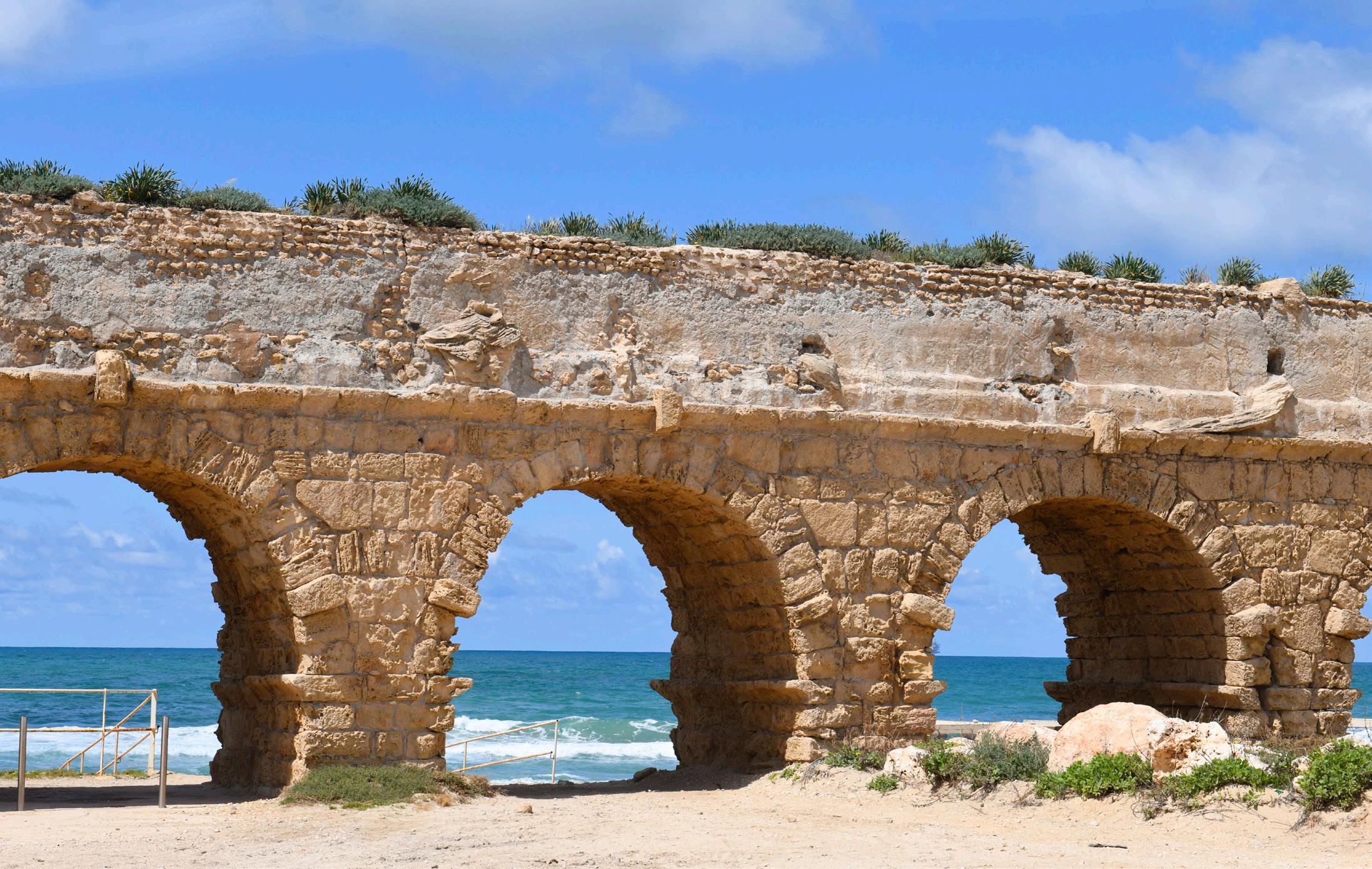
We hire a car and leave Tel Aviv to go in a northerly direction. We stop at Caesarea, where archaeological remains of structures from the time of the Roman king Herod the Great (37-4 BC) can be found. The ruins of an aqueduct close to the sea form a photogenic picture. Through the circular openings we look at an azure blue sea. Two ultra-Orthodox Jews arrive with a picnic basket. They proudly wear their tallit , the typical poncho-like garment with the long tassels at the corners. These are said to have a numerical symbolism for the 613 commandments and prohibitions that they must adhere to. We ask if we may take a picture of them. After some hesitation, they agree, as long as we promise not to post the photo on social media. They seem a little awkward. They want to know where we come from.
“Belgium, Antwerp,” we reply. 'Ha, Antwerp!', a broad smile appears on their faces. “We've been there. In the Lamorinièrestraat.” That is possible, because it is located in the middle of the Jewish quarter. During our trip, we will notice several more times that there is quite a bit of contact between the ultra-Orthodox community in Israel and those in Antwerp and Brussels.
Ultra-Orthodox Jews wear always the tallit , a poncho-like garment with long tassels at the corners.
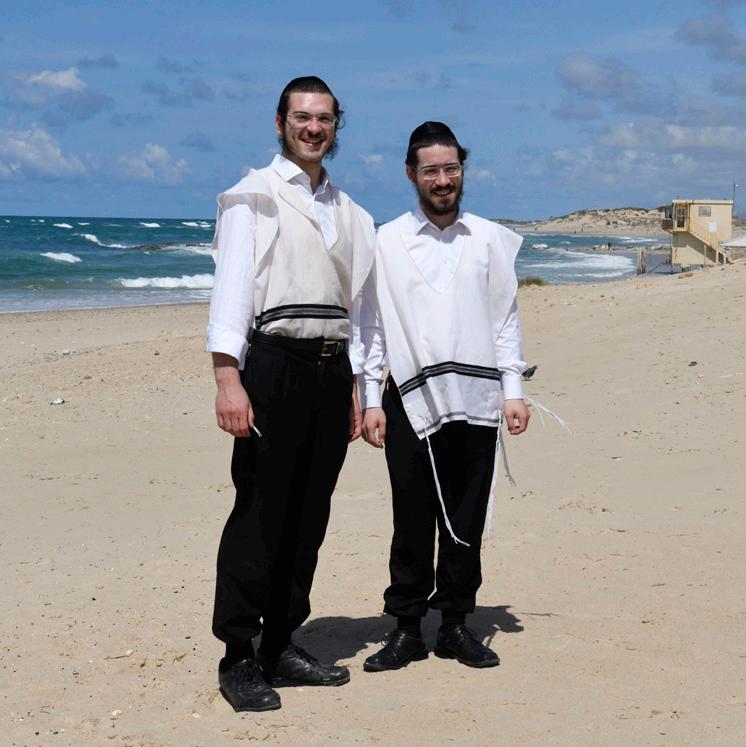

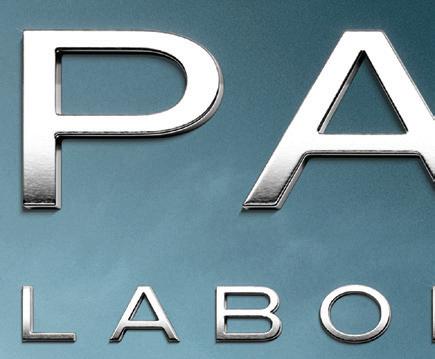

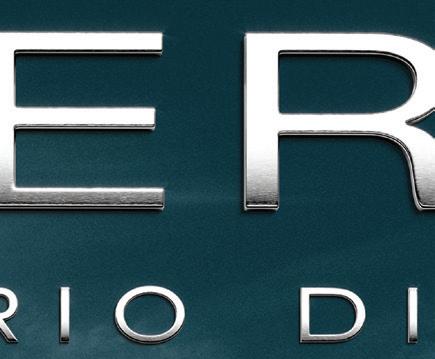
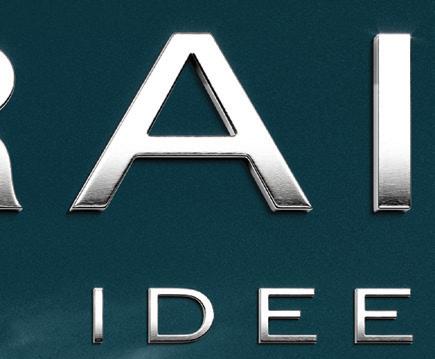





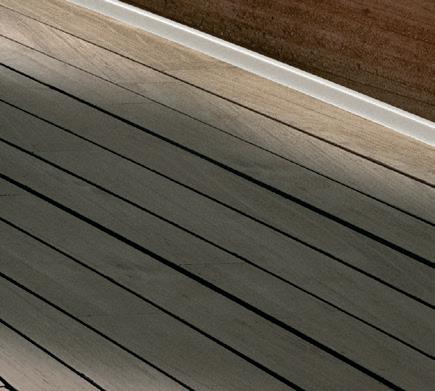
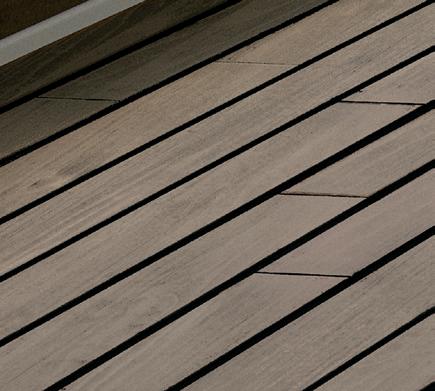
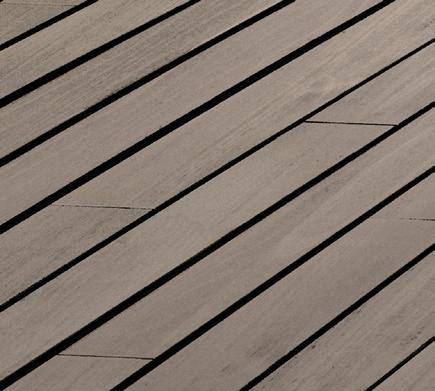



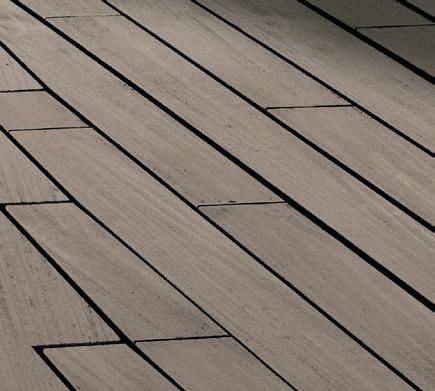
Haifa is Israel's third largest city with an important port. There is an expression that says: Praying is done in Jerusalem, feasting in Tel Aviv and working in Haifa. Given the bustle of activity in the huge seaport, the latter is certainly true. With its many steps and steep slopes, Haifa reminds us a bit of San Francisco. The showpiece of the city is formed by the Bahá’í Gardens . Like an illusion, the nineteen terraces of the beautiful French garden unroll downwards in perfect symmetry. Halfway up the mountain, the gilded dome of a mausoleum glistens. Bab is buried here, one of the two founders of the Bahá’í Faith. Another religion, we think, as if there weren't enough in Israel already. But the Persian-origin religion, which emerged sometime in the mid-1800s, has an interesting take on things. The Bahá’í teachings preach unity between all people and all religions. The main message of the Bahá’í faith is that there is only one god and that all religions are reflections of this one god. Perhaps the followers of the Bahá’í faith are right and it is all one melting pot. In any case, it would be the solution to all religious conflicts in a volatile Israel.
For: "On the seventh day, God rested from all his work which he had done." (Genesis, II, 2) The Sabbath is the weekly day of rest in the Jewish religion. It starts on Friday evening at sunset and ends on Saturday evening, also at sunset. During the Sabbath, Jews are not allowed to work, drive a car, cook, write, carry anything, or operate any electrical device. Orthodox Jews adhere very strictly to these rules. What is allowed? Praying, going to the synagogue, reading the Torah, visiting family and friends, and yes, sex is also permitted.
We are amazed at the many implications that the Sabbath also has for liberal Jews and non-Jews and how it impacts on all aspects of daily life. Society is in a kind of sleep mode. There is hardly any public transport, all Jewish shops but also many other ones are closed and even in an international luxury hotel such as the Kempinski we cannot get a hot meal until the end of the Sabbath. A salad and a sandwich are possible, but not a pasta or even a bowl of soup, tea is allowed, but not a cappuccino and hotel services are kept to an absolute minimum. Even the lifts go into Sabbath mode and stop automatically on every floor because well, lifts are electric and only function when you press a button and that's not allowed on the holy day.
Like an illusion, the nineteen terraces of the beautiful Bahá’í Gardens unroll downwards in perfect symmetry.

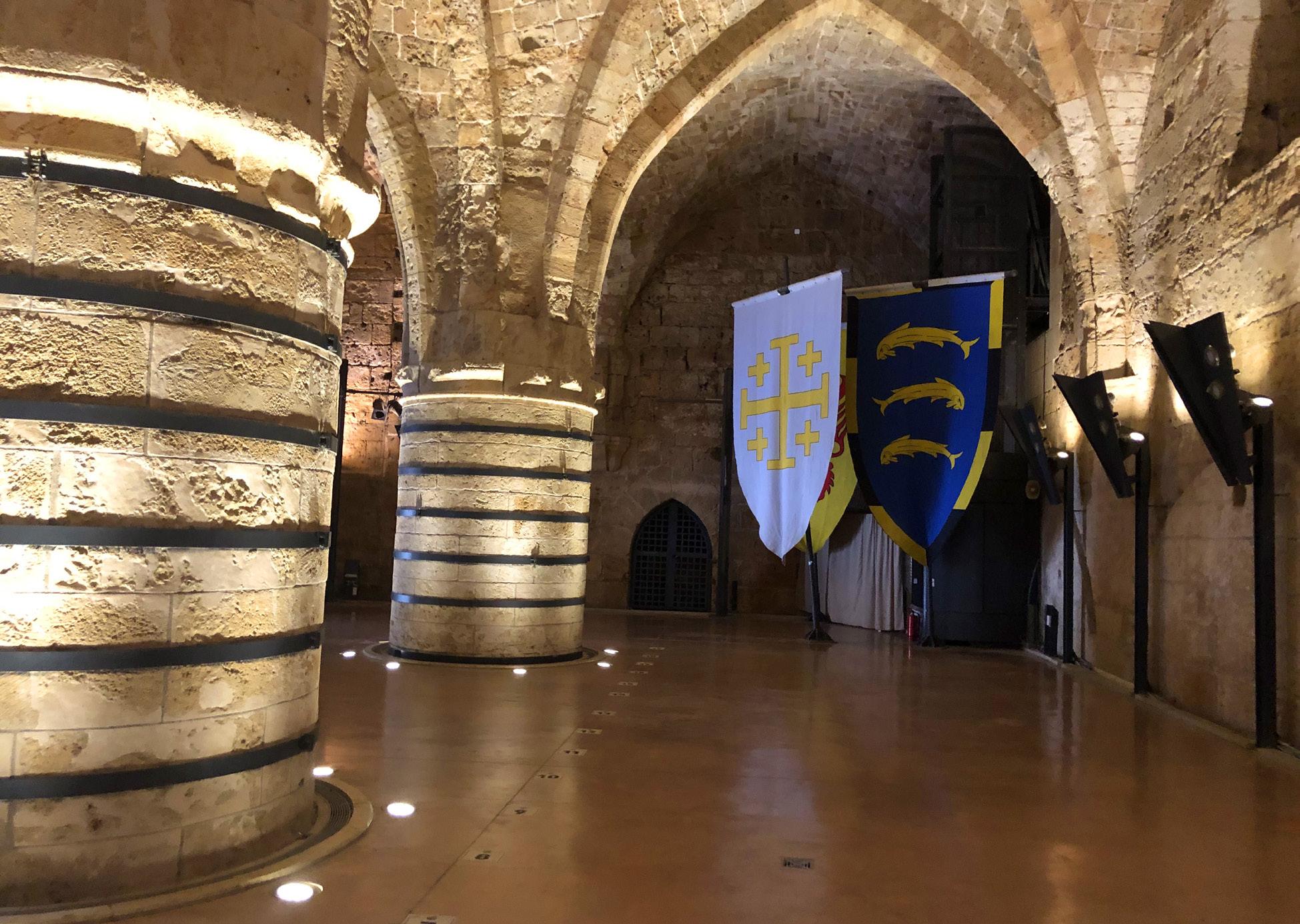
Coveted by many, conquered by many and lost by many, Akko is a historic city with a past full of wars and a succession of rulers. Everyone has passed through it including the Greeks, the Romans, the Byzantines, the Crusaders, the Mamluks, the Ottomans up to Napoleon and the British. With its maze of alleys, busy souks and slender minarets, Akko has a characteristic oriental appearance. On every corner you will find a kiosk where you can smoke a hookah. There is nothing to suggest that there is a completely different world underground. In 1994, archaeologists discovered large parts of a crusader city underneath the present-day Akko. The city was excavated, restored and opened to the public. We wander through corridors with beautiful groin vaults past enormous knight's halls and tombs. Through headphones we get explanations for everything we see. This is history come to life. In the meantime, the archaeological excavations continue unabated. No doubt more historical treasures will come to light.

In 1994, archaeologists discovered large parts of a crusader city under present-day Akko.Underground knight's hall in Akko.
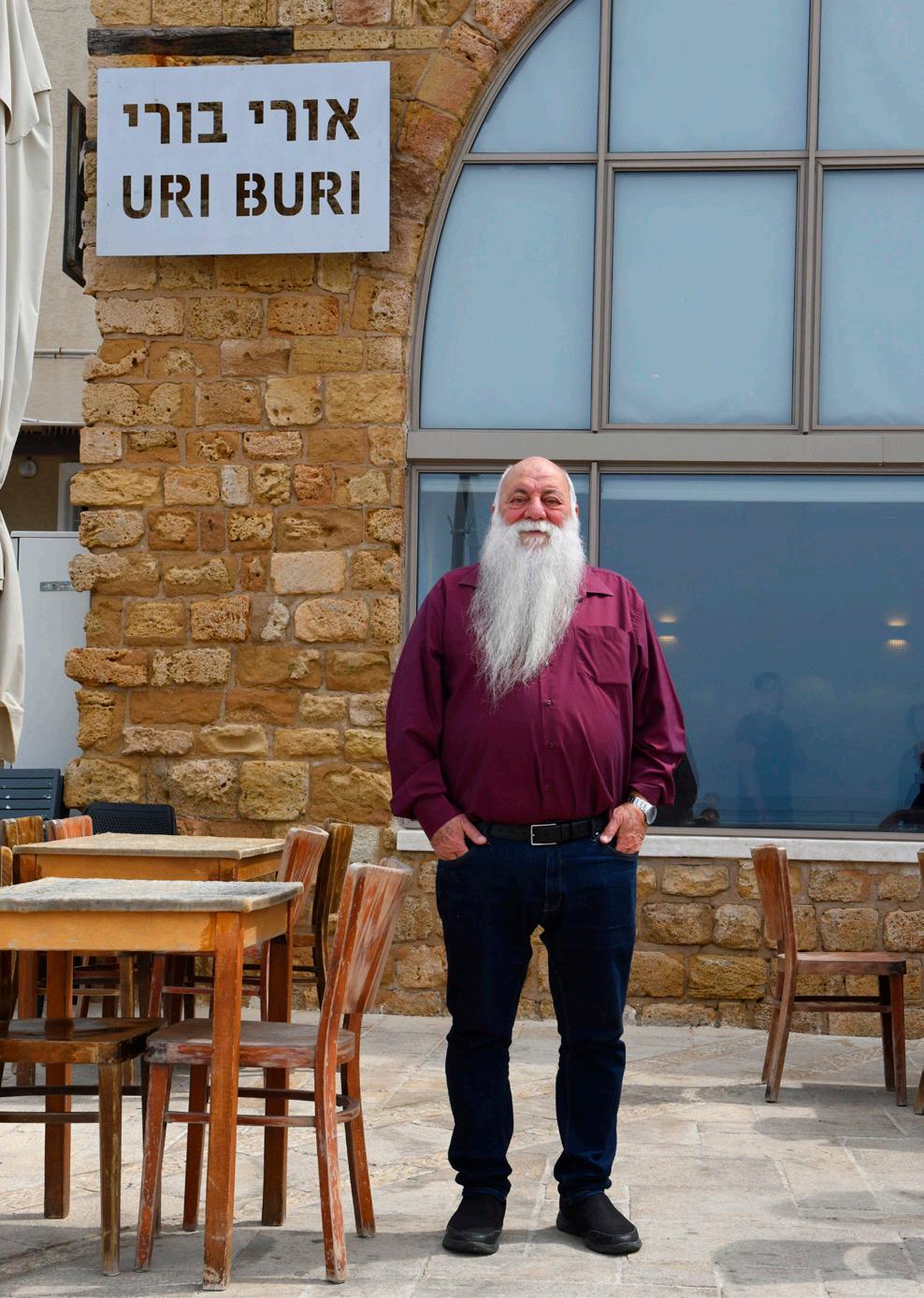
One of the best fish restaurants in the world, acclaimed and applauded by many, is not in fact situated in one of Israel's major cities, but in the small town of Akko. If you want, you can eat à la carte, but the idea is that you take the chef's daily menu, which consists of a succession of dishes that you share with your table companions. It continues until you can't eat another bite, but by then you will have had a memorable meal. We enjoyed: a fish soup with coconut, catfish with beetroot, squid with different dips, trout ceviche, scampi in an aioli-coriander sauce with homemade bread, sea bass with cauliflower puree and to finish, a kiwi soup with Pernod, basil and a scoop of passion fruit sorbet.
The melodious name of the restaurant Uri Buri is a combination of the owner's first name "Uri" and the word "Buri" which means fish. We talk to Uri Jeremias whose iconic long white beard has become his trademark. He actually speaks quite good Dutch. “I spent some time in Belgium in the 1960s. I left school when I was sixteen and started traveling. I knew from a very young age that I was different from other people. Now everyone talks about ADHD, but that concept did not exist then. I had been very fortunate that my parents had complete confidence in me and let me be. I'm not a cook at all, but I have lots of ideas for recipes that fall outside the mainstream. If you have taken a cooking class, you have learned to cook in a certain way, a way that you will continue to use. You may put your own stamp on your dishes, but the way of cooking will not change. If, like me, you have never learned to cook, you start with the product and see completely different possibilities that lead to completely new dishes. Have you tasted my ice cream yet?” asks this self-made man and he dishes up ice cream of black and red pepper, ice cream made of dates and even geranium ice cream. Delicious! This man is still brimming with ideas.
 The stunning Golan Heights.
The stunning Golan Heights.
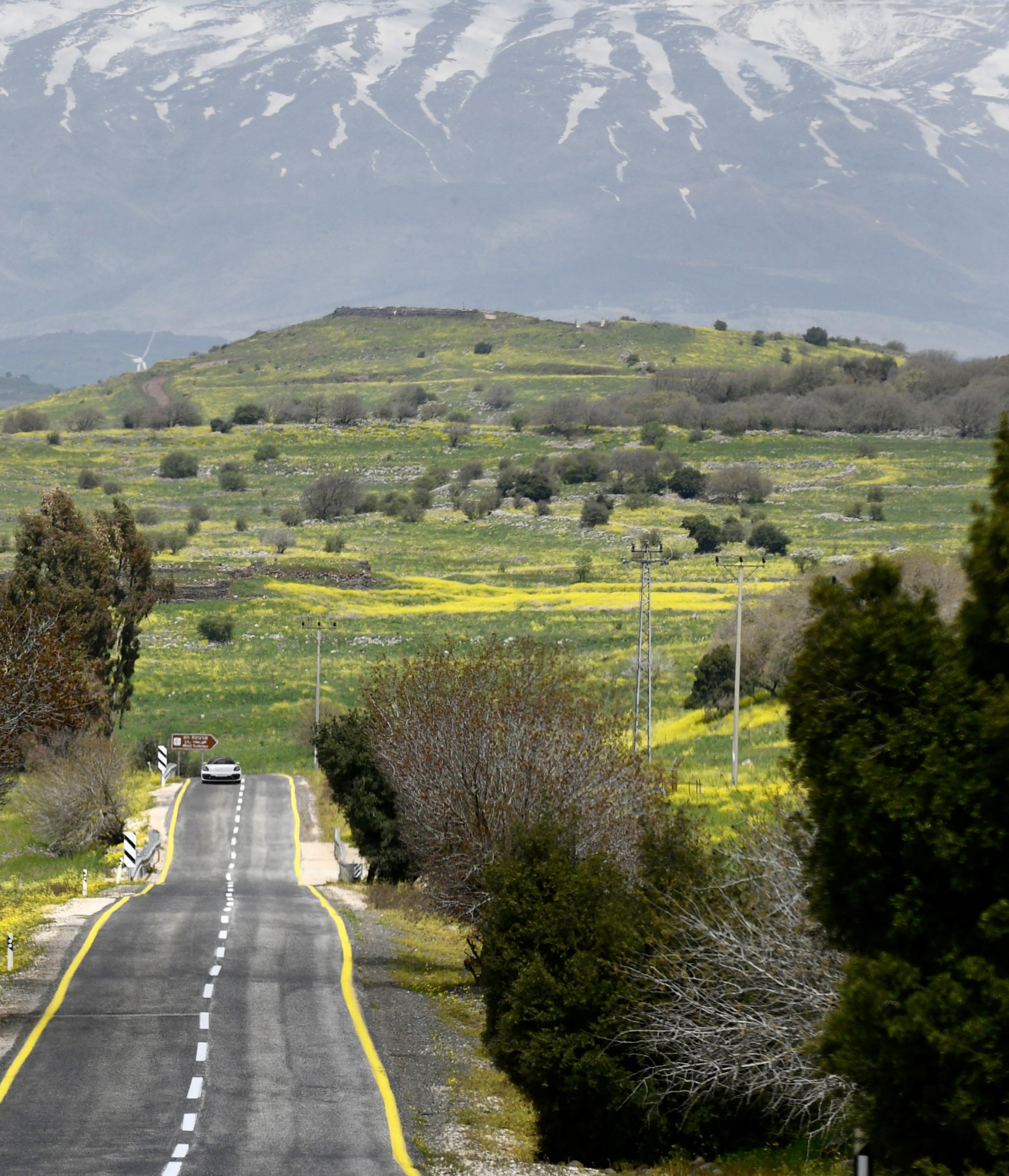
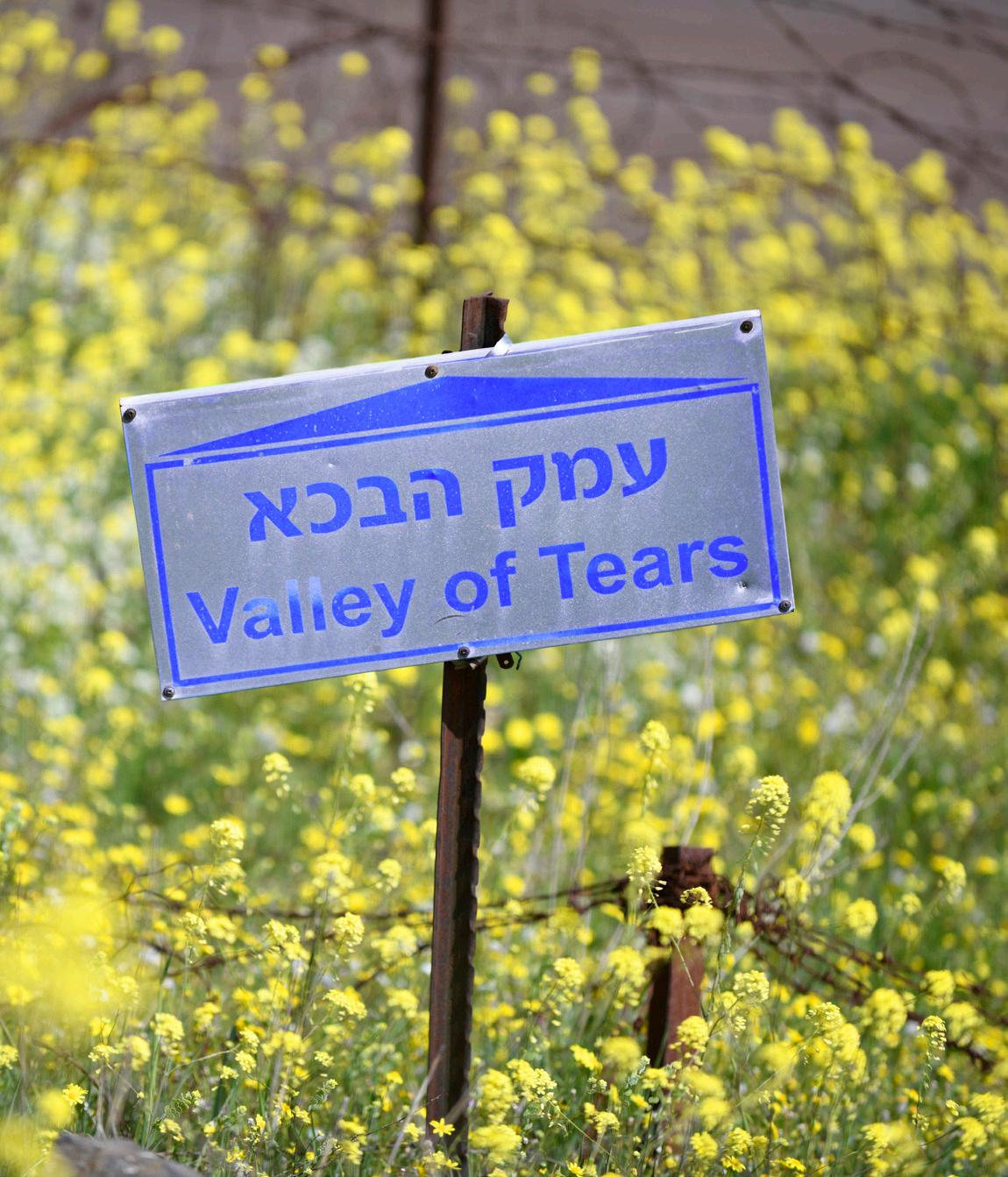
The Golan Heights is a beautiful mountainous nature reserve in the north of Israel, bordering Syria and Lebanon. We drive on a fantastic road that rolls out like a ribbon in front of us and enjoy the spectacular landscapes. Fertile valleys dotted with pink, purple and yellow wildflowers alternate with cypress forests. It is an oasis of calm. In the distance we see the eternal snow on top of Mount Hermon. In winter you can ski here. The ski area is not big, but Yaroslav told us he sometimes goes there at weekends. As we approach the Syrian border, ruins of bunkers and wrecks of burned-out tanks crop up here and there. Apparently, it's not that peaceful here after all. For decades, Syria and Israel have been fighting over possession of the fertile Golan Heights. Initially, the high plateau belonged to Syria until Israel conquered it in 1967 during the Six-Day War. In 1973, Syria tried to reclaim the Golan with a large-scale surprise attack but failed. Israel turned out to be too strong an opponent and Syria was defeated. From Mount Bentan, we look out over the area where there was so much fighting. Because of the many losses on both sides, this place was named the 'Valley of Tears'. We look at the barbed wire and the untouched nature that lies behind it. The horror of the war is still palpable here. If only we were a little closer to peace …
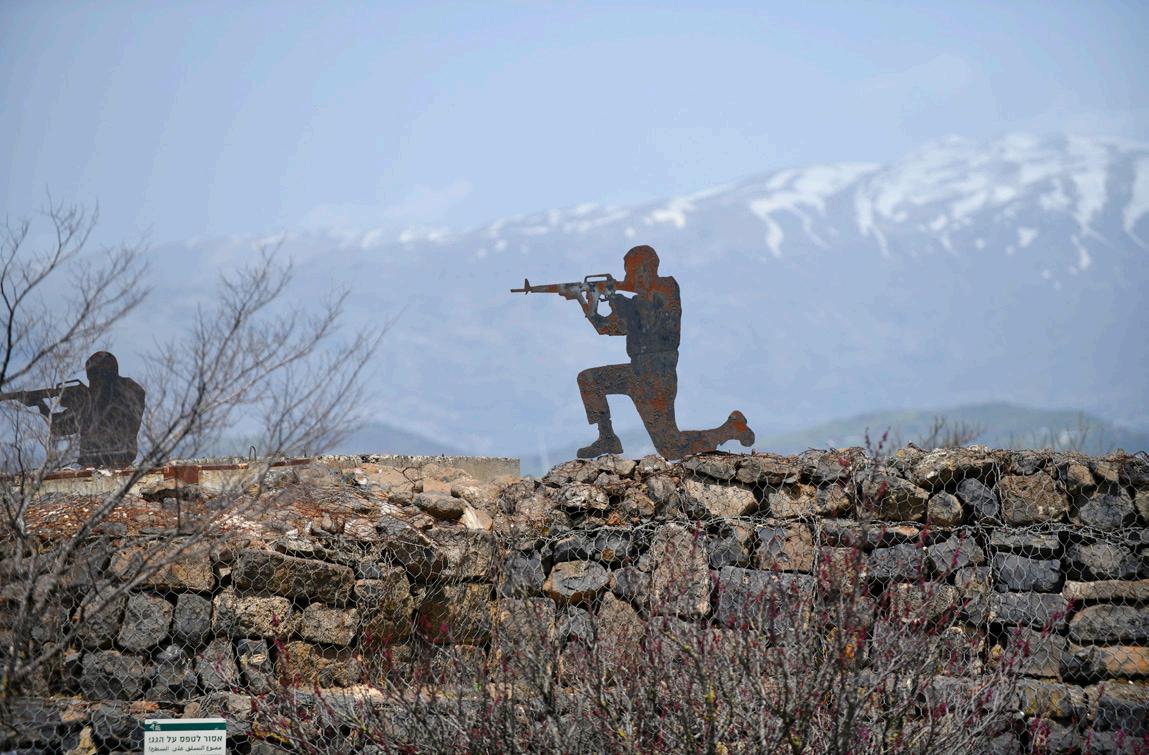
For decades, Syria and Israel have been fighting over possession of the fertile Golan Heights.



Nazareth is where Joseph and Mary lived and where Jesus spent his childhood. The main attraction in the town is the Basilica of the Annunciation , built on the spot where, according to the Bible, the archangel Gabriel appeared to Mary with the message that she would give birth to the Messiah. The basilica is the largest Christian church in the Middle East. 'Ecce virgo concipiet et pariet filium' is carved in white marble above the entrance door. 'Behold, the virgin shall conceive and bear a son.' It is not here, however, but at the Lake of Galilee, that Jesus set the mark of what would become the Christian faith. There, in one of Israel's most beautiful natural areas, many miracles took place extensively described in the Bible. Jesus walked on the water there, calmed a storm, multiplied loaves of bread and brought about a miraculous catch of fish. All stories can be found in the Bible.
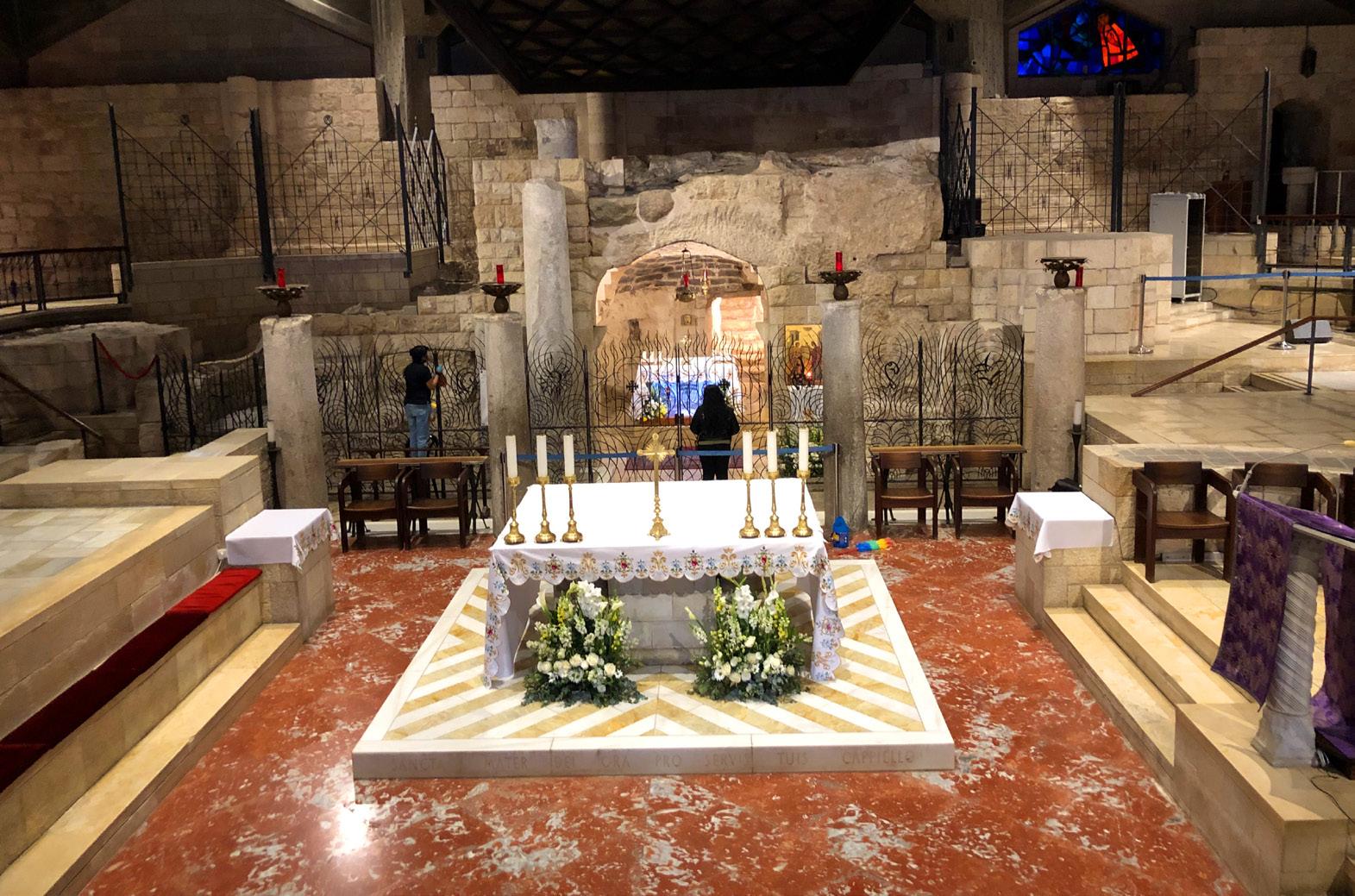
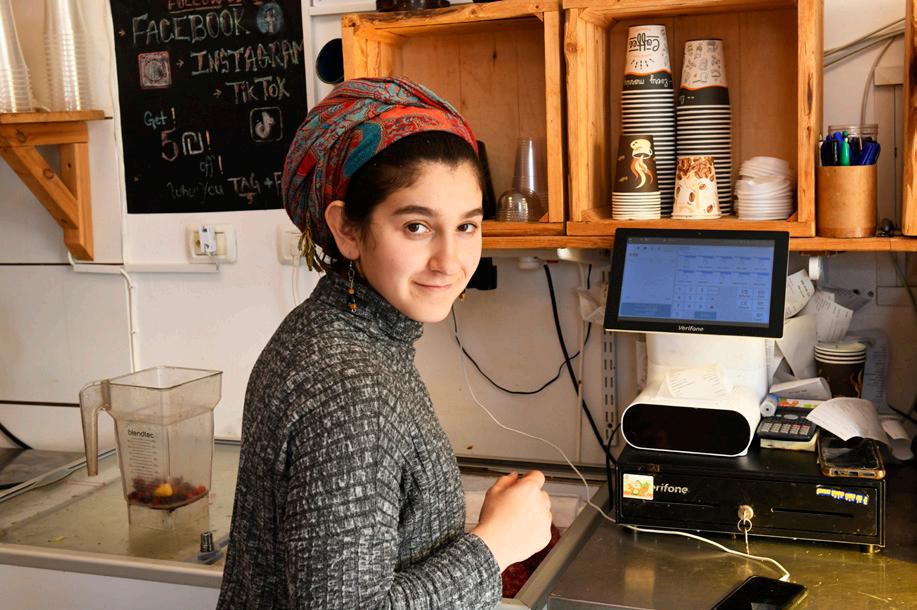
Safed is to Jews what Nazareth is to Christians. According to the Talmud, Safed is one of the four holy cities, along with Jerusalem, Hebron and Tiberias. The city is located at 900 metres above sea level, making it the highest city in Israel. Only Orthodox Jews live here. We recognise them by their black and white clothing, curls, long beards and black hats. Somewhat to our surprise, it is not difficult to make contacts. Young people in particular are curious and want to know where we come from. They throng to get their picture taken. Cheerful music sounds from a small bar. Naomi sells all kinds of fresh fruit juices and homemade pastries. From her fluent English, we infer that she hails from somewhere else. "I'm from New York," she says. "I've lived here for seven years now, and I love it. Away from the rat race. Here you can find yourself again. We also see many Jews strolling through the streets with suitcases. In Safed you can follow a lot of courses that brush up your knowledge of the Jewish faith and there is clearly a lot of interest in that. This is also the centre of Jewish Kabbalah, a mystical movement within Judaism that seeks a deeper truth in the secret world of numbers and letters from the Torah. All very mysterious, but that's rather the point.
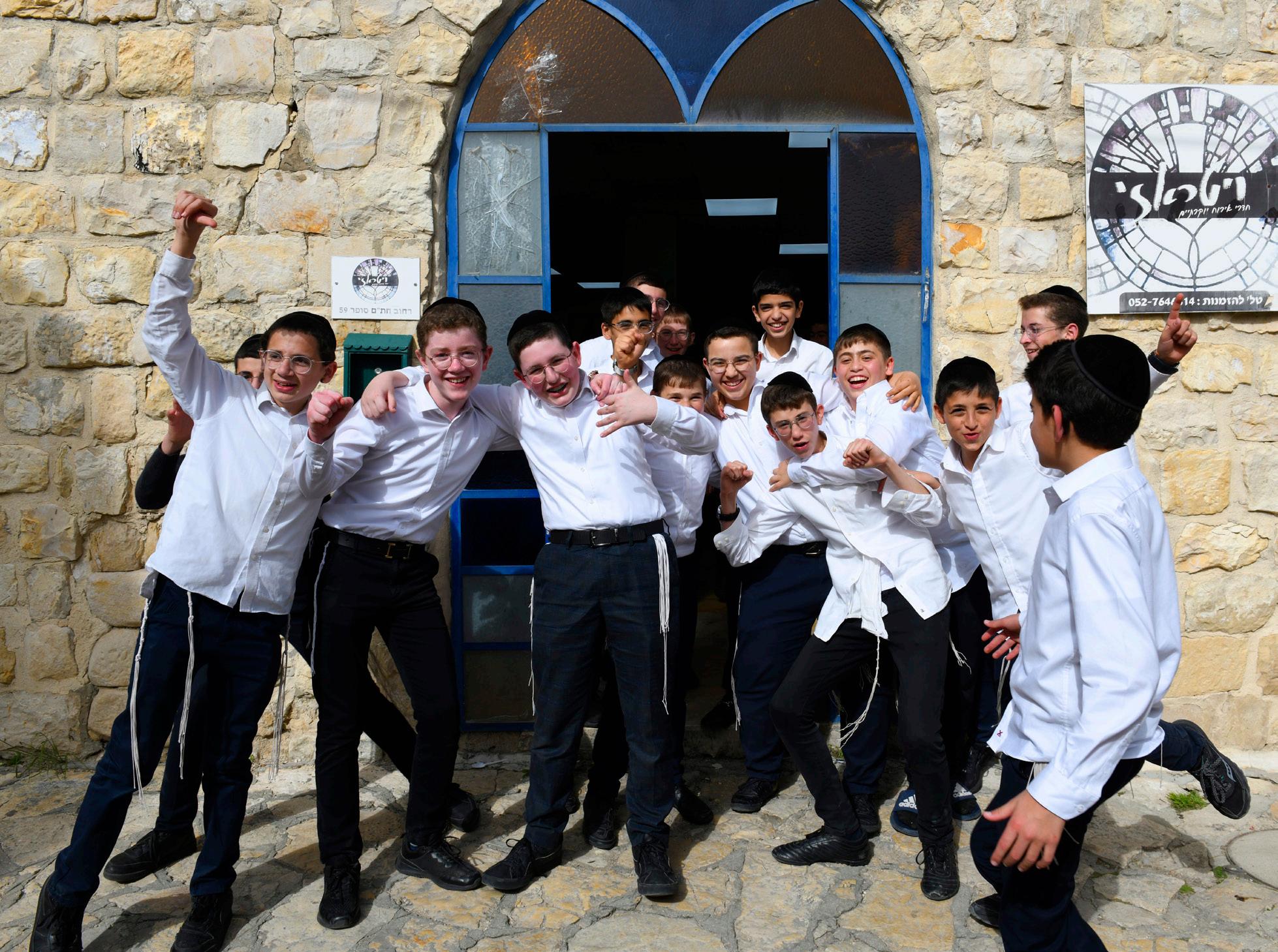

The mysticism of the Negev desert is much more accessible to us. An area of 12,000 km 2 of immense emptiness, at the same time desolate and wonderful. An area of sand, rock rubble, canyons and whirlwinds that blow the fine sand into the air. It is impossible not to be enchanted by the grandeur of this landscape. The Negev Desert has three craters, Makthtesh Ramon being the largest. A giant hole, more than 400 metres deep and 40 kilometres long, caused by centuries of erosion. From atop a rocky outcrop we have a fantastic view of this geological wonder with its whimsical shapes and numerous colours.
the boundless horizon of the desert.
The Six Senses Shaharut Resort ingeniously blends withSix Senses Shaharut Resort, Negev Desert.
In the south of the Negev lies a real paradise. The Six Senses Shaharut Resort looks like a mirage. The resort merges so ingeniously with the boundless horizon of the desert that we almost drive past it. The low walls resemble the remains of an old fortress, and nothing suggests that behind this ochre yellow fence lies an extremely luxurious resort. It has only been open for two years, but the project has been in the works for more than a decade. The Six Senses complex consists of sixty villas that are fully integrated into the topography of the desert. The colours of the environment blend seamlessly into the interior, in which many pieces of furniture come directly from local craftsmen. The peace and quiet are almost tangible. From our wall-to-wall window, we look out over an almost supernatural panorama where sunsets merge with orange dunes to form black-blue skies studded with stardust. Every sunrise here guarantees a moment of pure magic. The symbol of Six Senses is a triangle with six dots, one for each of the five senses. The sixth dot represents intuition. In this environment it is not at all difficult for us to understand that all the things we cannot see or touch are just as real as the things we can see or touch.




No less than three monotheistic religions - Judaism, Christianity and Islam - consider Jerusalem to be the centre of the world. That should be a unifying factor, you would think, but nothing could be further from the truth. It has been creating violence and conflict for centuries. For Jews, Jerusalem is the city of King David, for Christians the place where Jesus was crucified and buried and for Muslims the place where the prophet Mohammed ascended to heaven from the mosque.
There is so much history clustered here that we hire a private guide. Danya is from the Netherlands and has been living in Jerusalem for many years. Although she is a practicing Jew, her cap and cheerful summer dress do not correspond to the stereotypical image we have of Jews. “Everyone has their own interpretation of the rules from the Talmud,” she explains. “Orthodox Jews are very strict with these rules. They will always be dressed in black and wear a prayer shawl and hat. They do this not only to distinguish themselves from others, but also because it makes them stand out and it means they cannot do anything that goes against the many rules they are supposed to follow. However, the majority of the Jews are non-Orthodox and dress in a modern way. The head is always covered out of respect for God. Men can do so with a yarmulke or a hat and women with a scarf or wig. It just depends on what you prefer.”
The Mount of Olives is the best starting point for a visit to the holy city. From here we have the best view of Jerusalem with its many churches, synagogues and historical buildings. The blue-tiled Rock Temple with its golden dome glitters in the sun and draws all the attention. The hill is also home to the oldest Jewish cemetery in the world, a sea of tightly packed stone graves. They are said to number 150,000. Like black ravens, a group of Orthodox Jews stands at a grave. They pray and read psalms. “They are relatives who honour the anniversary of the death of the person lying there,” Danya tells us. We ask why Jews always sway during prayer. “The movement helps with concentration,” Danya explains. “It puts you in a kind of trance and then it is easier to focus on the prayer.”

Judaism, Christianity and Islam all regard Jerusalem as the centre of the world.Ultra-Orthodox Jews at the grave of a relative, Mount of Olives Jerusalem.

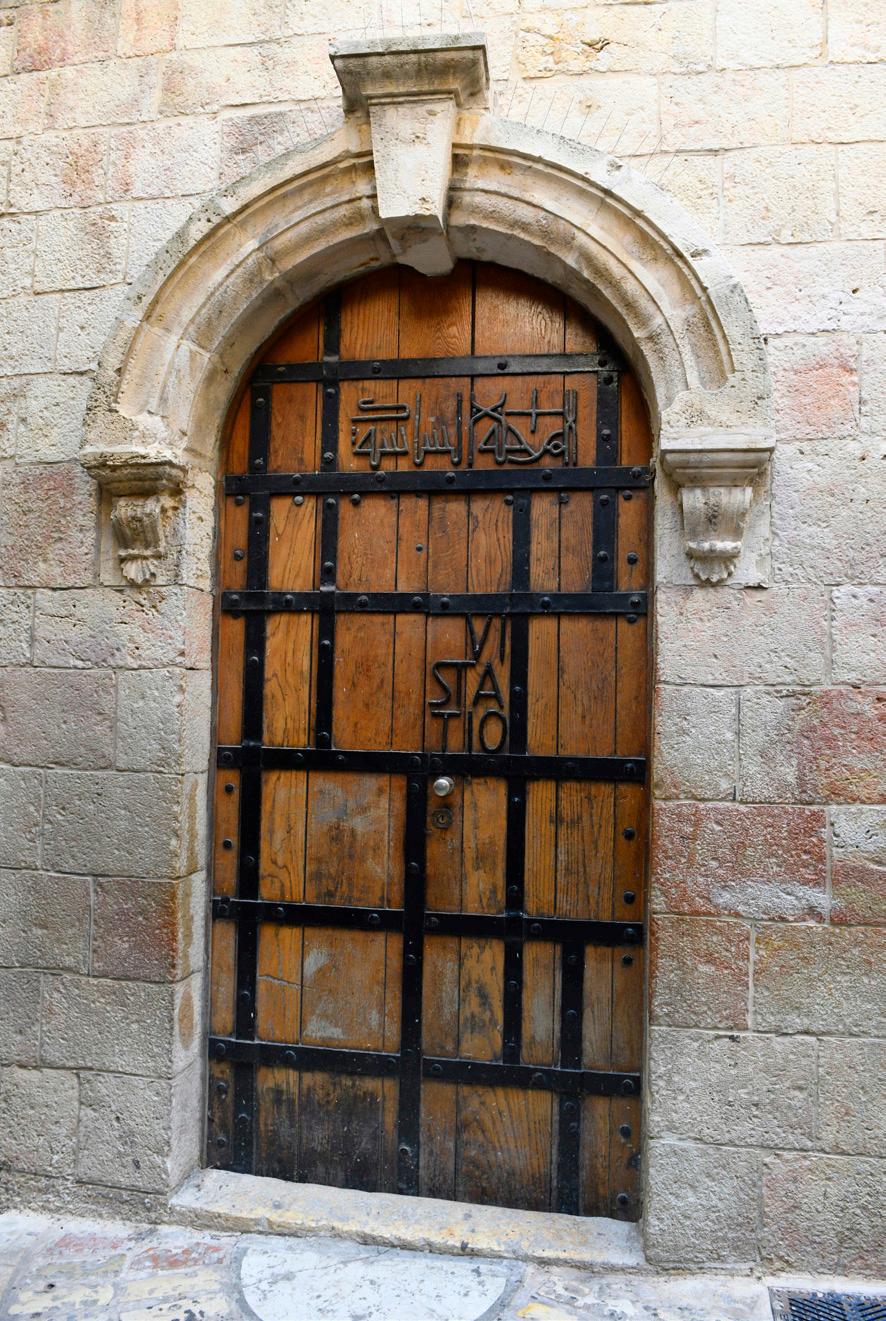
In the old, walled centre of Jerusalem, you can still clearly see that this place has always been a crossroads of religions. The Ottomans built the impressive city walls in the 16th century. Within the ramparts there are four quarters: an Islamic, a Christian, an Armenian and a Jewish one. There are no boundaries, but as we walk through the labyrinthine streets, we automatically notice by the people when we move from one neighbourhood into another, from one culture to another, from one religion to another.
In the Jewish quarter we visit the Orthodox Hurva synagogue

We climb to the roof via a beautiful cast iron spiral staircase on the outside wall. It provides us with a magnificent panorama over the Old City. In Orthodox society, the synagogue is the domain of men. Women are admitted, but it is believed that due to their many household chores, they do not have time to attend a service. The atmosphere in the synagogue is surprisingly relaxed and jovial. People are talking and walking around. The synagogue is therefore not only a place for prayer, but also for study and gathering.
In the Christian quarter we walk through the Via Dolorasa and follow the road Jesus travelled from the court of justice
to the Golgotha hill where he was crucified. Crucifixion was not an uncommon punishment in Roman times. On the way, according to the Bible, Jesus stopped fourteen times, the so-called stations. They are marked on the stone houses of the narrow alley. Believers stop at each place to pray and commemorate the martyrdom of Jesus. We enter the Church of the Holy Sepulchre , built on the spot where Jesus died and was buried. The management of the church has been fought over for centuries. At the moment it is in the hands of six Christian confessions: the Greek Orthodox, the Roman Catholic, the Armenian Orthodox, the Syrian Orthodox, the Coptic and the Ethiopian Church. Relations between the various churches were so bad at some points in time that the keys of the shrine had to be entrusted – oh the irony –to Muslim families.

The square in front of the Wailing Wall - also known as Western Wall - is very busy. A number of boys are celebrating their bar mitzvah and that creates a festive atmosphere. Bar Mitzvah is a very important moment. Now that they are thirteen, the boys will be responsible for following the 613 commandments and prohibitions prescribed by the Talmud. The whole family is dressed in their Sunday best. Parents and grandparents are very proud and the boys who are the centre of attention seem to realise that this day is a pivotal point in their lives. A family from New York has also travelled to Jerusalem for the bar mitzvah of one of the sons. The women have coordinated their outfits and are dressed all in white. They shine. They ask if we can take some pictures of them, because the girl who promised to take on that task has forgotten her camera in the excitement of the day. We exchange contact details and send them our photos later that evening. In a corner of a square, a group of Jews is standing with prayer shawls pulled over their heads. They resemble ostriches.
We linger on the square for a while and walk to the wall - separately, because there is a separate part for men and women. We would have liked to peek at the many notes that are stuck between the stones of the wall, but that is not allowed, because the prayers, requests and thoughts on them are only intended for the eyes of God. It is strange that a pile of stones – the piece of wall is only 150 metres long and 15 metres high – enchants so many people. It is the only piece of wall that remains of the Jewish temple complex that was destroyed by the Romans in AD 70 and that still causes sadness 2000 years later.

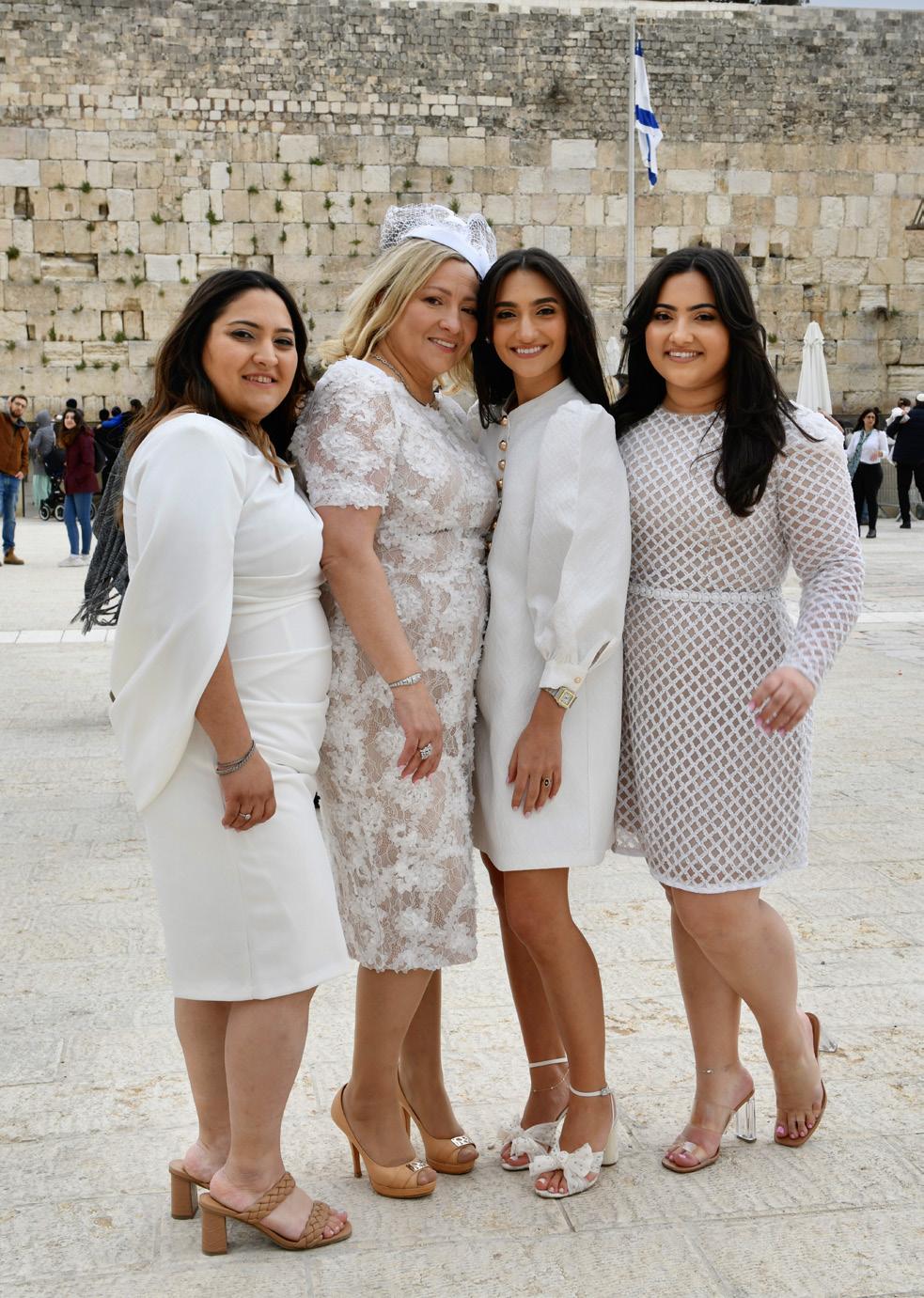

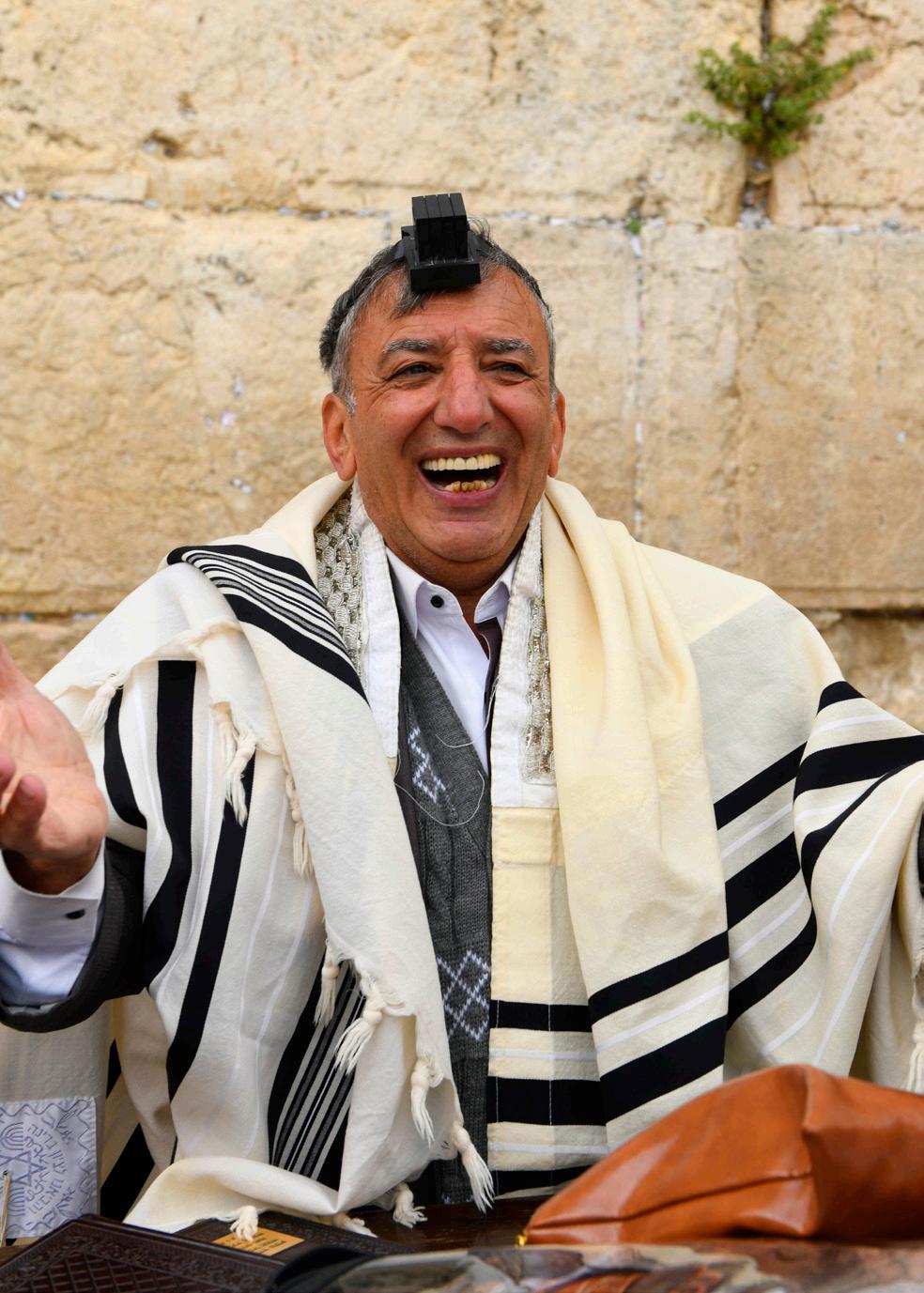
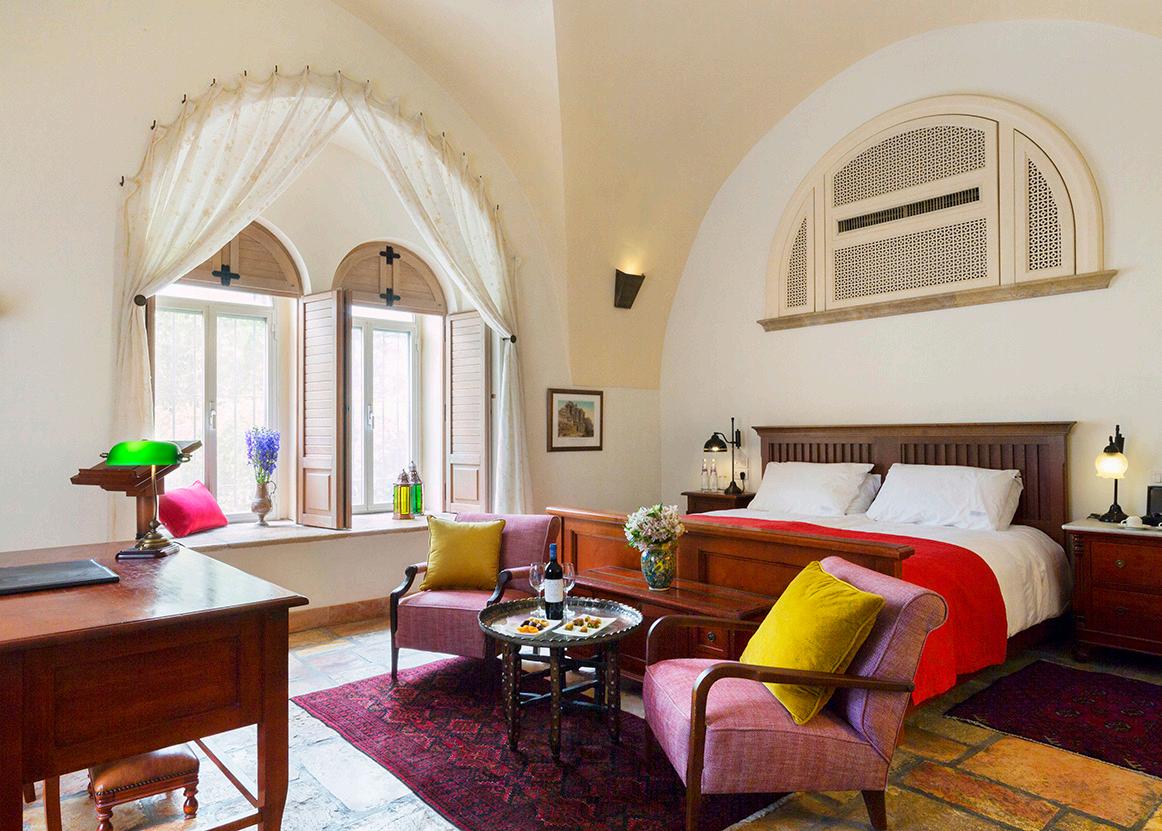
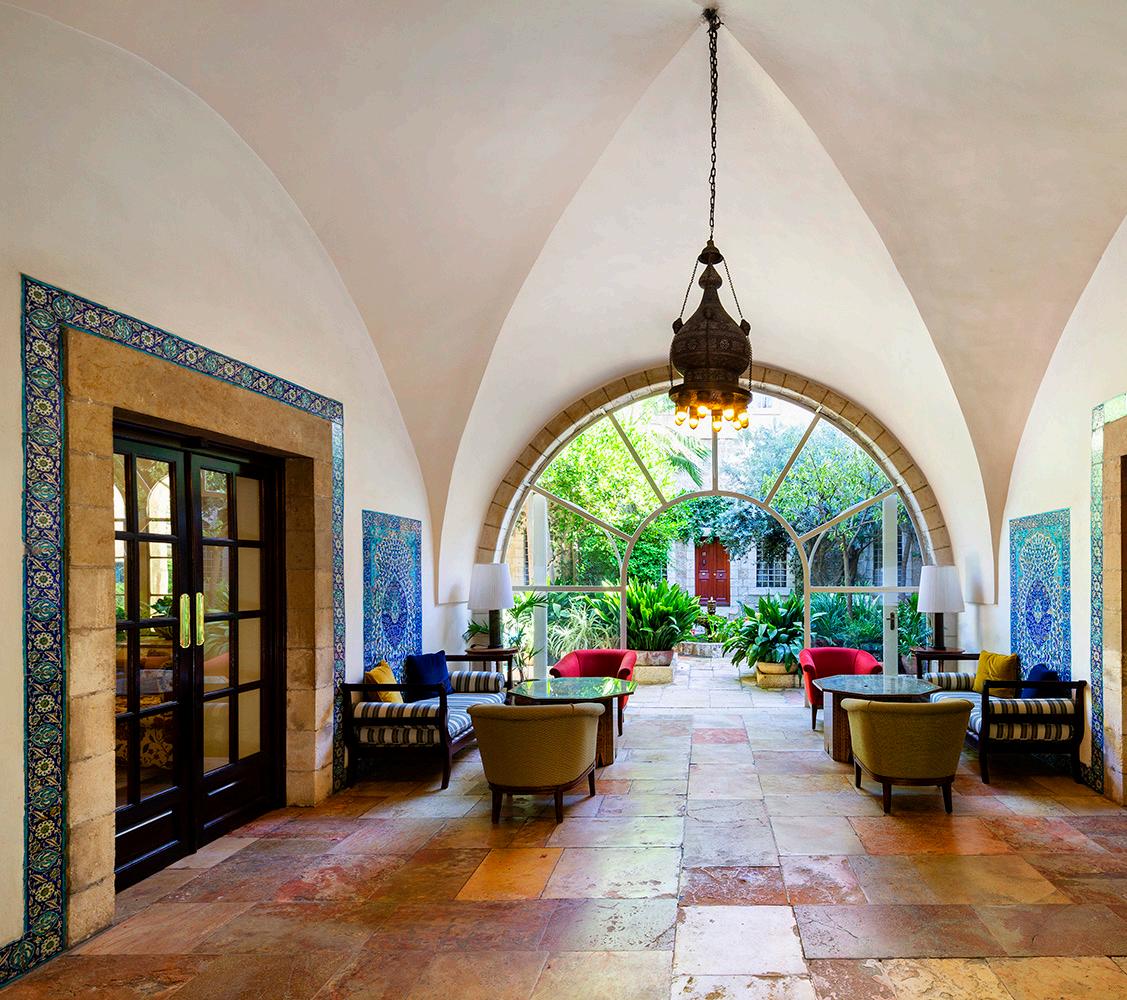
 American Colony Hotel, Jerusalem.
American Colony Hotel, Jerusalem.
Jerusalem is a city that touches and intrigues you in so many ways that it is nice to be able to catch your breath in a good hotel in the evening. We couldn't have chosen better than the iconic American Colony Hotel . The fourstar hotel has a rich history dating back to the late 1800s when a group of American Christians moved to Jerusalem under the guidance of Horatio and Anna Spafford. The couple had suffered gravely and lost four children in a ship fire. To recover from all that grief, they decided to leave their hometown of Chicago to find peace in the Holy City of Jerusalem and help people in need. They founded a Christian community and established good relations with both the Jewish and Arab populations. When the group grew to 150 people, they moved into the immense house of an old pasha. In 1902, the initially communal house grew into a hotel where mainly Western and American travellers and pilgrims sought shelter. The American Colony Hotel has always been known locally as a neutral site, outside of the country's turbulent politics. It was not owned by Arabs or Jews, but by Americans and has always had friends from all sectors of Jerusalem's mixed society. Today, the hotel is mainly the meeting place for international press correspondents and diplomats. The hotel is still owned by the Spafford family. It has a unique, elegant atmosphere with colonial and oriental influences. Everything around you points to the fact that this is a place with a rich past.


Almost all important places in the life of Jesus have already been reviewed. What is still missing is the place where he was born. For that we have to cross the Israeli-Palestinian border, because Bethlehem lies in Palestinian territory. With our passports in hand we queue up at the military border post. We can go straight through. Checks happen on the other side, we later hear from our guide Amer, when entering Israel. Amer is a cheerful Palestinian who speaks perfect English. He leads us through the streets of Bethlehem, a pleasant town with cobbled streets and colourful houses that can boast of being the most touristy city in the West Bank. The population here is almost exclusively Muslim. The fact that Jesus was born here is a welcome source of income for them.
Like the Holy Sepulchre in Jerusalem, the Church of the Nativity is managed by Armenians, Orthodox Greeks and Christians alike. The main focus is of course on the place where Mary gave birth to a son. That place is located in a small cave in the church. It is a tight squeeze to get in, but Amer has his contacts, and we are allowed to enter through the exit. That saves us at least an hour of waiting in a long queue. Inside is an altar with a silver star below it. Here the son of God is said to have been born. We find it hard to believe that 2023 years after the date, the exact place of this event is still known, but the many visitors clearly don't doubt it for a second.
Back out on the street, a man spontaneously invites us for a cup of spicy mint tea. From his terrace we see how Bethlehem is surrounded by white compounds. “Israelis live there,” says Amer, following our gaze. “They buy land here and build houses on it.” Is that allowed? we ask. “Of course not,” Amer replies, “but what can you do about it?” When we passed the border post, we saw a large sign that clearly stated that we were entering Palestinian territory and that it is not accessible to Israelis. “See all those yellow license plates?” Amer asks. “They're all Israelis. Palestinians drive with white license plates. Don't think that you can cross the border post to Israel with such a number plate, but the reverse is possible, and no-one asks any questions.”
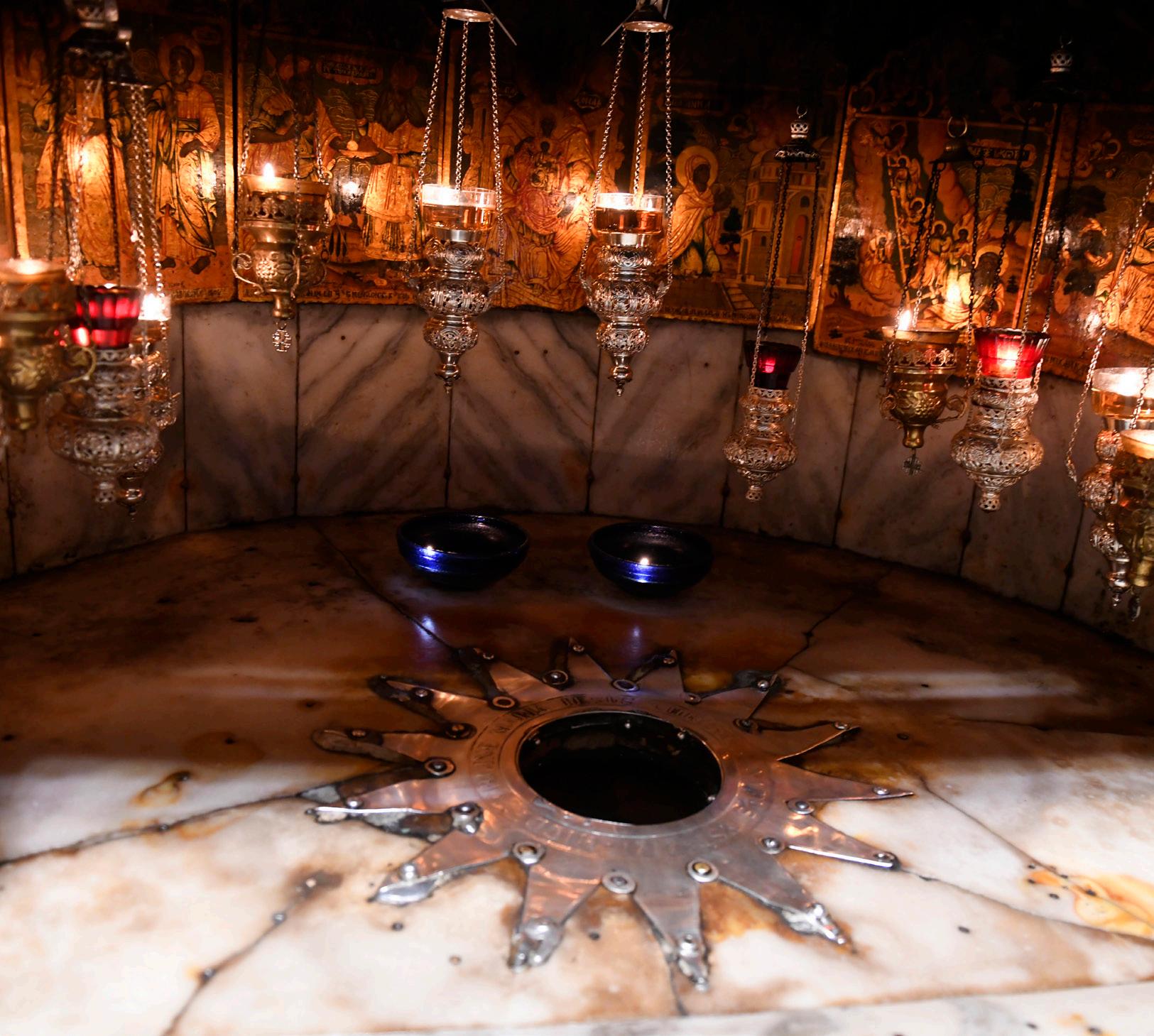

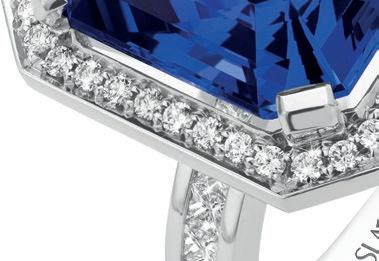

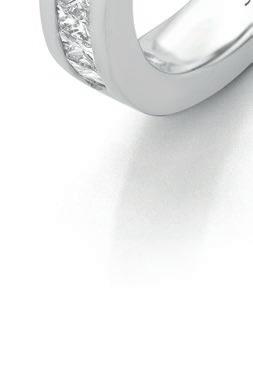





Amer says he has an MBA degree and that when he was young, he wanted to go abroad. “I received a scholarship to continue my studies in Seattle for three years. My father thought I absolutely had to seize that opportunity so that I could make something of my life. All my papers were in order: I had the official admission documents from the university, I had a visa from the American embassy, and I had my plane ticket and despite all those documents, the Israelis never let me cross the border. There was no actual reason to stop me. I wasn't on any blacklist, and I came from a decent family. I reported at the border seven times and was sent away each time. I was so angry and frustrated that ordinary Israelis had the power to ruin my future. If you live in the Palestinian territories, you have nowhere to go. You are imprisoned forever. I would like to travel as much as you do, but that is impossible. Now that I'm a guide, I can make up for that lack a bit because I meet people of different nationalities who give me an insight into their lives.” Amer tells his story calmly and doesn't seem to harbour any resentment, but it does make us think. We can't imagine living with so little freedom.
It gets even more harrowing when Amer takes us to the Israeli wall. Its construction began in 2002, in the middle of the Second Intifada, officially to deter terrorists who could carry out attacks on Israel. The barrier was built on the Israeli-occupied West Bank of Palestine, partly along the Green Line, but also largely on Palestinian

territory, which means that Israel has illegally annexed additional territory. The wall not only separates Israelis from Palestinians, but especially Palestinians from Palestinians, which leads to heartbreaking situations. With its barbed wire, cameras, watchtowers and ditches, the ten-metre-high concrete wall certainly does not look friendly. The wall has many names depending on which side you are on. Proponents use the terms security fence or barrier wall; Palestinians and opponents of the construction call it the apartheid wall (an analogy with South Africa) or the wall of shame (an analogy with the Berlin Wall). The media usually talks about the Israeli Wall or the Israeli West Bank barrier. The wall is full of emotionally charged messages, drawings and testimonials. Many artists express their protest against the wall through captivating paintings, including some by famed graffiti artist Banksy.
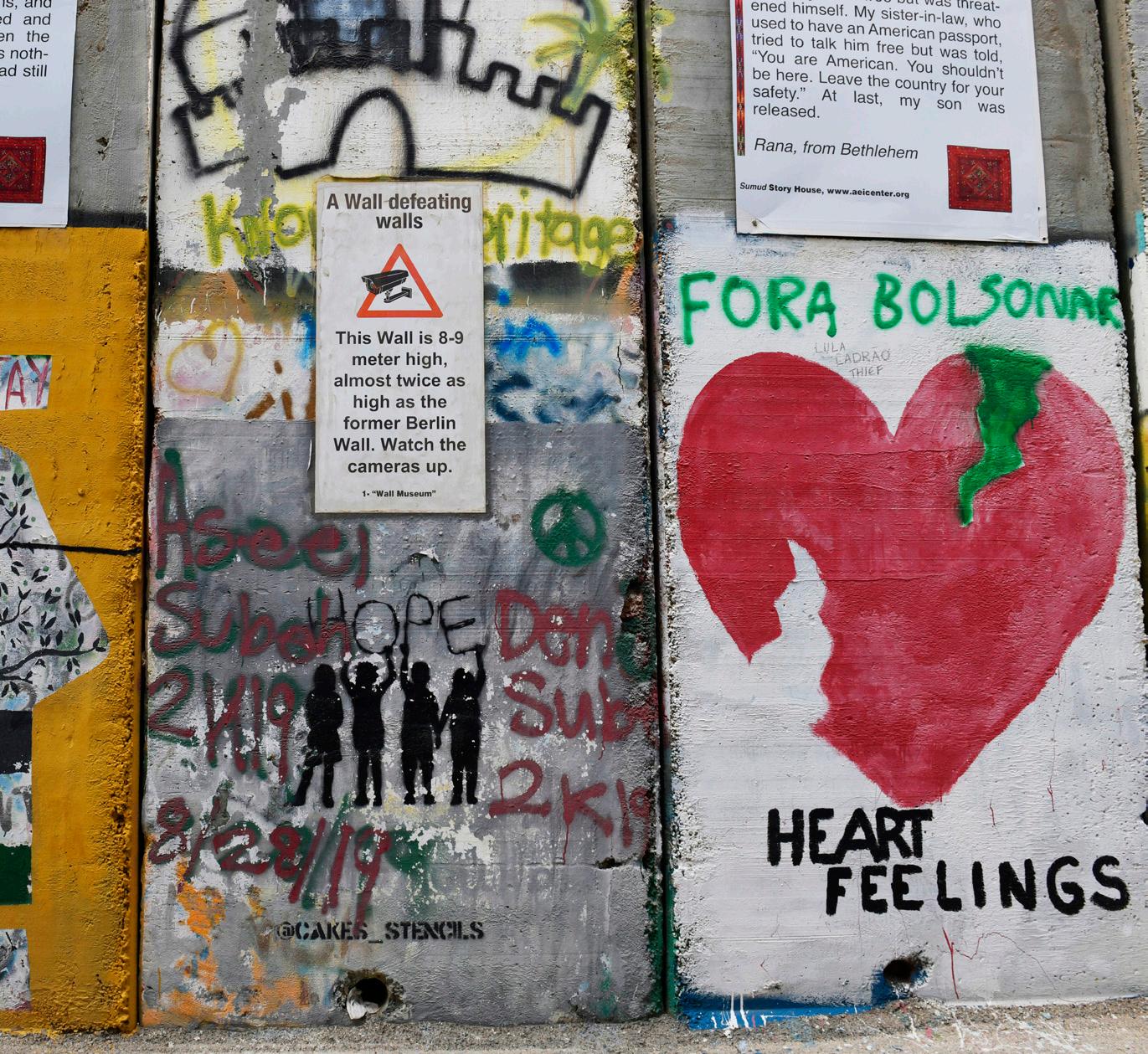
The Walled Off Hotel is near the wall. The hotel is 100 years old and was there long before the wall came. Right in front of the hotel is a beautiful trompe l'œuil. It is a painting depicting an imaginary crack in the wall. It's like looking through that crack right at Jerusalem, the view that the guests of this hotel used to have. The hotel is still in use. Inside there is a small exhibition room where the history of the creation of the wall is explained in words and images. There is also an old telephone. We lift the receiver off the hook and hear a voice say, “This is Brian from the Israeli Intelligence Service. We are going to bomb your house. You have 5 minutes to leave your house.” It gives us goosebumps. Imagine getting a call like that.

After visiting the West Bank, we see Jerusalem through different eyes. We still enjoy the contagious spiritual joy that is there, but also feel the tension. The many heavily armed patrols in the streets give us an uneasy feeling. We notice how young the soldiers often are. They constantly stop Arab youths. What does that do to twenty-year-olds, we wonder, when you can be checked and considered suspicious at any given moment? That must be pretty humiliating. Individuals with bad intentions may be arrested in this way, but to achieve that, many others who have nothing to hide are constantly put through the wringer. The ultra-Orthodox Jews, on the other hand, are given excessive privileges in our eyes. When they walk through the streets, they are escorted like kings by at least three soldiers. The difference in treatment is very striking.
Israel is a country that gets under your skin because it raises far more questions than answers. The pilgrim in the Old City, the Arab merchant, the Jewish guide, the Palestinian taxi driver… each tells a different story. What struck us most on this journey is how destructive faith can be. Those ten noble commandments - found in the Bible, the Torah and the Koran - who lives by them? Israeli society is in a perpetual state of division, discontent and strife. But for a country so beautiful, so rich in history and culture, there must always be hope, right? Let's keep believing in that.. ♦

With thanks to:
- Middenoostenreizen.com & Travel Legends
- Shay Duany, CEO Orchid Sports Cars Israel
- Aya Ashkenazy, Marketing Manager Porsche Israel
- Hadar Pode, Managing Director Porsche Digital Tel Aviv
- Yaroslav Stepanov, Porsche owner
- Guy A. Lindt, General Manager The American Colony Hotel Jerusalem, www.americancolony.com


he Porsche dealership building in Tel Aviv benefits from the Mediterranean sun shining generously in through the large windows, adding extra sparkle to the beautiful Porsches on display in the showroom. Here we meet Shay Duany, CEO of Orchid Sports Cars Israel. A very passionate man who values the Porsche brand. He likes to be close to his customers and prefers not to walk around in a stiff suit, but in a more casual attire. For the photo, he immediately puts on a colourful Porsche jacket.
The Orchid Sports Cars Group is one of the largest Porsche distributors in the world. The company boasts thirty years of experience. It is the exclusive importer of Porsche cars to Israel and the sole dealer for Lausanne, Geneva and Bern in Switzerland. Orchid Sports Cars Israel is a subsidiary of Orchid Sports Cars International. The showroom and service center in Tel Aviv opened its doors in 2016. We are working with a small and very efficient team of 48 colleagues, everyone of whom is fully imbued with the Porsche spirit.
Pretty well. In 2022, we sold 250 Porsches. That's a nice figure. The best sellers are the 911 and the 718. In Israel, Porsche's sports models are especially popular. We attach great importance to building and maintaining good contacts with our customers. We do this by organizing events, road trips and experience days. Tomorrow, for example, we have a 'Women’s Day' to which we have invited 670 women. We did
it last year and it was such a great success that we were immediately asked to organize it again this year. When we send someone an invitation, they can bring friends and family along and that works.
How is the Taycan doing in Israel?
First of all, let me mention how important I think it is that electric technology exists. In an age where sustainability is becoming increasingly important, also a car brand needs to get on board. When it comes to electric cars, everyone always talks about driving range. Porsche has a clear vision on that aspect, stating that most people do not need a driving range greater than 500 kilometres. And I couldn't agree more.
Are there enough charging stations in Israel?
Anyone who buys a Taycan automatically gets a home charging station with it. There are around 700 charging stations across the country, which is already quite a lot. But there are still not enough of them. It is a work in progress.
Does someone buying a Porsche in Israel fit a certain profile?
The average age of a Porsche buyer is something like 40. That's the age at which people usually like to 'afford' themselves something special. Those who buy a Porsche usually know very well what they want. They are people who love the design, the performance, the sportiness, the power, the sound... everything that typifies Porsche. Our customers are well informed and know the difference between the models. A Macan S and a Macan GTS, for example, are very different cars. Our customers know that.
Do you have a particular sales policy?
I like to guide customers through their buying process. Someone who normally drives a BMW and steps in here because he wants to buy a Porsche should not buy a 911 Turbo S right away. I suggest him to start with a regular 911 or possibly a 911 S and eventually switch to a more powerful version later. There has to be a story, a history, there is no rush. Customers appreciate my approach. 'Shay, you're right', they say. That's how you win trust. I know my clients and sense what is best for them. I always see things in the long run. Pushing and selling right away, that's not what it is about. It's about building an honest and open understanding with the customer.
That is a beautiful attitude.
For me, it is the only right way. We don't sell cars, we sell experiences. I see it as my contribution to represent Porsche's heritage in the best way. ♦
"We don't sell cars, we sell experiences."
Shay Duany
alking to a Palestinian Porsche owner was not on our wish list because we assumed we wouldn't find one anyway. But that was beyond our fantastic guide Amer. 'A Porsche? Let me enquire.' Within the hour, Amer had actually tracked down a 911 owner and we had Joseph Handal on the phone. Whether he was interested in talking to us about his Porsche? He was. A day later, we meet him in Bethlehem. His white Porsche stands like a dove of peace in the street. The fact that Joseph Handal is a cameraman and works for Al Jazeera is an additional bonus.

How did you handle to buy a Porsche?
Porsche was my dream car since childhood. But it was obviously very difficult to realise that dream. I live in the West Bank. When you live in this part of the world, you are very limited in what you can do. Importing a car is almost impossible. There are so many hurdles and rules. You have to get both Israeli and Palestinian permission, and even if you get that, there are still a hundred and one obstacles that come your way. But I succeeded. In 2002, I imported the Porsche directly from Germany: a white 911 with a 996 engine. A magnificent car! Because of all the taxes, customs formalities and import duties, I finally paid double the initial purchase price, but I am extremely happy with the car. Unfortunately, I cannot drive it much. I live in a small area and can't just drive to Jerusalem, for instance.
How do you go about maintenance?
Well, that is quite a challenge. It requires a lot of creativity and patience. There is a Porsche dealer in Tel Aviv, but I can't drive there. With my Palestinian number plate, I am not allowed to cross the Israeli border. Buying parts in Germany is not an option either, because then I run into the same problems as importing the car itself. As a result, I do everything myself. I look up tutorials on YouTube and get the job done myself. One learns by doing.
How do people react to your Porsche?
I am now mostly known as 'the man with the Porsche'. If someone does not know me and people refer to me as 'that man who drives a white Porsche', everyone immediately knows who is meant. There are no supercars in this region. I am the great exception.
What is your profession?
I am a cameraman and work for Al Jazeera, an Arabic international news television network based in Qatar. I work on news broadcasts and documentaries. I have been working for Al Jazeera's English-language section since 2006. This interview is a special experience for me. Normally I stand on the other side. (laughs)
What was it like for you when Palestinian-American journalist Shireen Abu Akleh was shot last year?
Horrible. Her death was a huge shock within the Arab world. She was incredibly loved. She worked as a journalist for Al Jazeera for more than 25 years and was always on the frontline in the conflict between Israel and Palestine. She had an infectious laugh and did not shy away from any confrontation. Several generations of Palestinians grew up with Shireen Abu Akleh's face on the television screen. She was truly an inspiration to all her colleagues.

"Due to all the taxes, customs formalities and import duties, I finally paid double the initial purchase price, but I am extremely happy with the car."
Joseph Handal
There were disturbances in Jenin, as often happens. Jenin is in the north of the occupied West Bank and has a large Palestinian refugee camp where clashes with the Israeli army regularly take place. The town is basically run by the Palestinian Authority, yet Israel believes it is allowed to carry out so-called security operations in the camp because they assume armed Palestinian militias are hiding there. In early May 2022, we knew a new Israeli raid was imminent. That's why Shireen and other journalists were in Jenin to report. I was also there and stayed in the same hotel as Shireen. Shireen entered the camp with a team on the early morning of 11 May because an exchange of gunfire between Israeli soldiers and Palestinian militants had been heard. Shireen was shot by an Israeli soldier though it was very clear to see that she was a journalist. She was wearing a blue bulletproof vest with PRESS written on it in large white letters. She was also wearing a helmet, but the bullet hit her just in the small part of unprotected skin under her ear. She was dead instantly. She was only 51.
You work in an area where a lot of violence takes place. Do you have no fear?

Of course I am aware of the dangers, but it is a conscious choice. I wouldn't want to do any other job. I really enjoy doing my job every day because. I also see it as a kind of personal obligation to report about the things that happen in my country. ♦
Thanks for this interview, Joseph, and keep it safe!
"I am obviously aware of the dangers as a cameraman in Palestinian territory, but I wouldn't want to do any other job."
Joseph Handal
JosephHandal at the mural of his murdered colleague Shireen Abu Akleh.
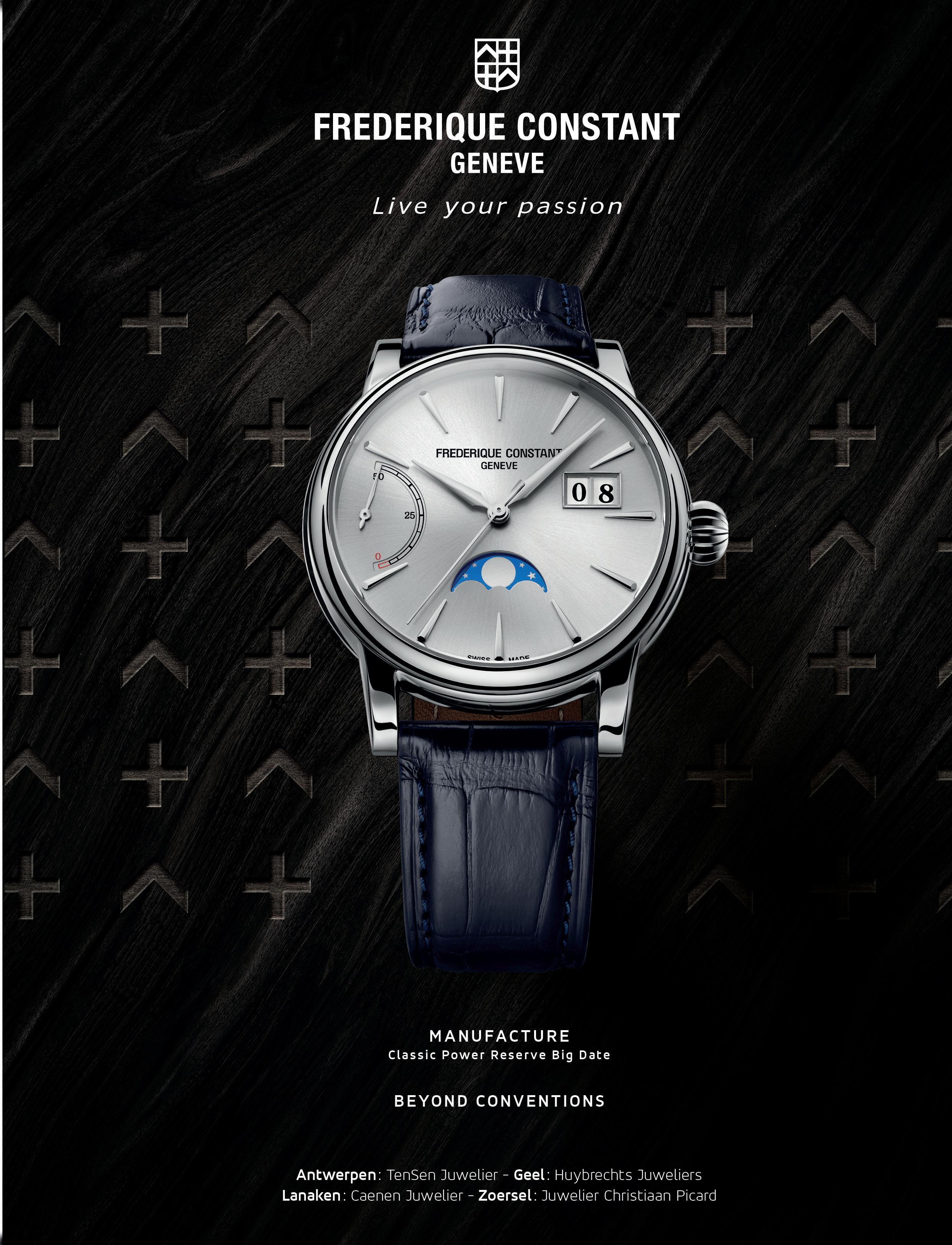
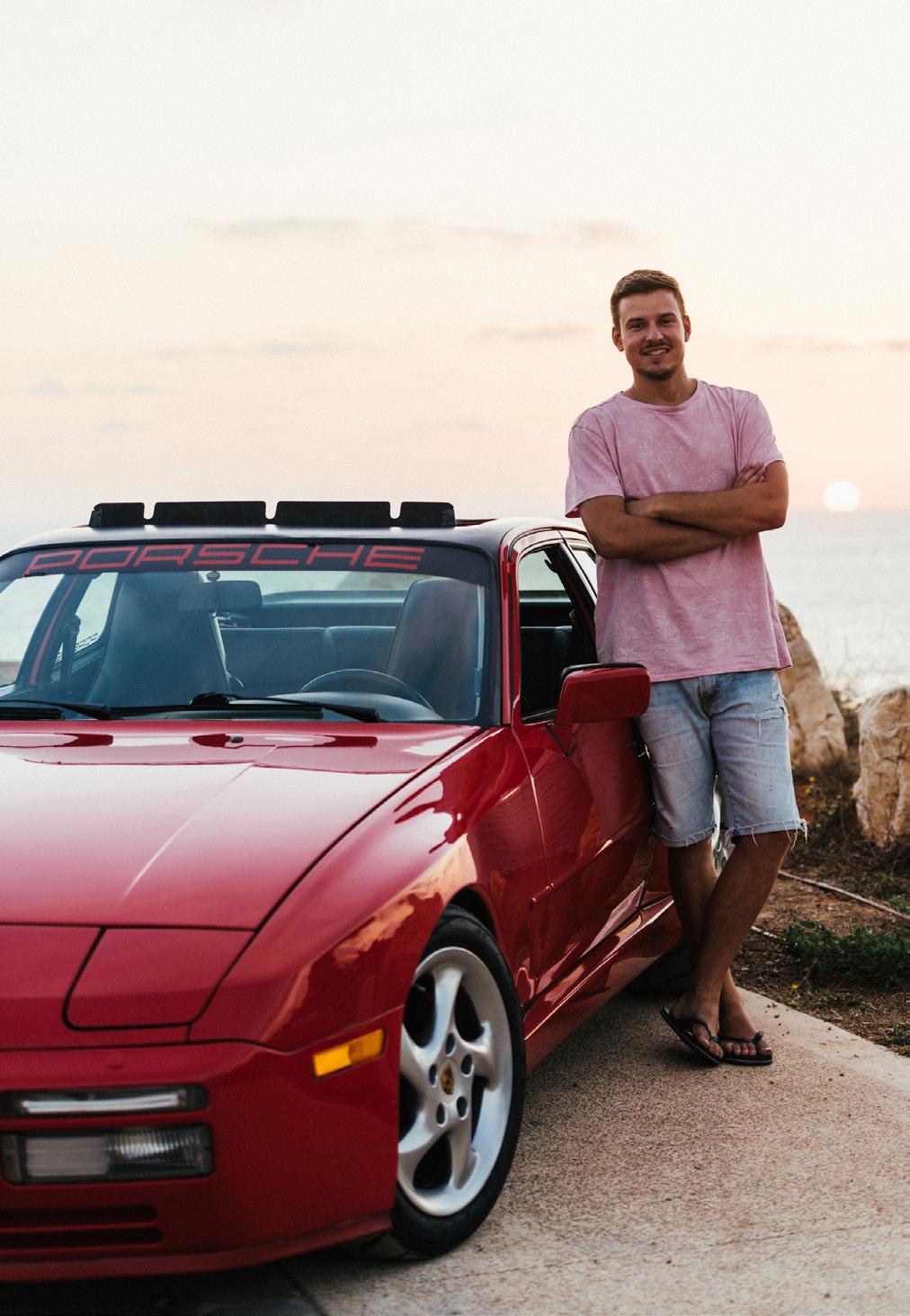
ou are young and you are full of dreams. And Yaroslav Stepanov knows perfectly well what he wants. When it comes to cars, he has lost his heart to Porsche and in particular to the striking 944. Right from our first meeting we have had a fantastic connection with this young thirty-something. He puts us in touch with many other Israeli Porsche owners and organises a magnificent Porsche road trip. Suring this, he drives a wrapped Taycan – supplied for the occasion by Porsche Centre Israel – but his heart goes out mainly to the retro gem he has at home.
I am 30 years old, I was born in Ukraine and moved to Israel when I was 9. My parents thought there was a better future for us here. If you see what is happening in Ukraine now, they were more than right. I studied economics and business management and work in the financial sector. There I mainly deal with cryptocurrencies. They are traded 24/7, which means that I work in shifts and regularly work at night as well.
That's an interesting question. Neither my girlfriend or I were born here. Our parents are Jewish, but we are not considered Jewish here. For example, we can't get married here. So it is a somewhat complex situation, but I do consider Israel my homeland. Israel is a difficult country that has to deal with many problems and that also translates into daily life. The war in Ukraine also affected and changed me enormously. I had to rescue my father, stepmother and brother from a war zone. That is the hardest and most drastic thing I have done in my life so far. I had so many scared nights. It was such a dangerous undertaking to get them to Israel.
They lived in Kharkov, one of the cities most affected by the war, and saw and experienced things that marked them forever. They were also not allowed to leave the country. My father and brother had to go to the front and my stepmother had to stay in Ukraine as a nurse to care for the wounded. So it was an almost impossible thing to get them out of there, but we succeeded with a lot of help from very nice people. People I didn't know at all called me to pass on tips, names and telephone numbers of diplomats, ambassadors, ministers, etc. That's the beauty of Israel. In emergency situations, people help each other. From the moment they hit a crisis, Israelis are the most efficient people alive.
How did your passion for Porsche come about?
I've always been fascinated by sports cars, especially the older generations, typically those from the 1990s. That may have something to do with my childhood. Those were the cars I grew up with as a kid. I think that every car fanatic is by definition a Porsche enthusiast. It seems impossible not to love Porsche. When I was 23, I already wanted to buy my first Porsche. I had saved some money and saw an ad for a Boxster. A few years ago, classic cars in Israel were a lot more affordable than they are now. But when I looked at the maintenance costs, I realised that they would also take a big bite out of my budget, so I put the idea to the side for a while.
But not for long.
No, I kept looking at Porsches on the internet and at one point saw some posts on Facebook from the Porsche 944 club. The 944 was a model that I had not seen anywhere and that I immediately loved. A very special model with that large rear window and folding headlights that give it its characteristic contours. I did some research to understand what kind of car it was and decided not to buy a Boxster, but a 944. At the time, however, none were for sale in Israel, which meant I had to look for one abroad. However, if you import a car into Israel, you are bound by a number of rules: either it must be a new car that is not older than two years or it is an old model that is at least thirty years old. You cannot import anything in between.
I came home late one night – I admit I was a little drunk – and quickly went on eBay to buy a new case for my smartphone. Out of curiosity I also looked at the 944s and I actually came across a listing on eBay for a 944 Turbo from a man in Chicago. I liked the car, I liked the price and I wanted to buy it. But I wanted to make sure I wasn't buying a pig in a poke. So I sent a message to the Porsche 944 club asking if the Porsche was a good deal. It was already midnight, but I immediately got responses. It all looked good, they said, but they advised me to get some more technical information from the owner. I did and it was all good. And well, one mouse click later I had bought the Porsche. It was a bit difficult when I had to tell my girlfriend Tanya the next morning: Hi honey, I bought a Porsche last night. (laughs)
"I've always been fascinated by Porsches from the 1990s. That may have something to do with my childhood."
Yaroslav Stepanov
When did you actually have the car in your garage?
That did not go smoothly. I had absolutely no idea how to import a car, what documents you needed and how to proceed. It took me some time to figure all that out. Fortunately, the members of the Porsche Club helped me with a lot of advice and assistance. Once the car was in the port of Ashdod in Israel, I had to drive there and back four times before I got the car. Every time there was something wrong with the papers. Enough to drive you crazy. The fourth time I drove to the port was on 17 January 2017. It was my birthday and when the authorities made a fuss again, I said: Listen, today is my birthday. I have to drive home in the car. Finally I got the green light. But even then the misery was not over. When I got to the car, I saw that it had two flat tires and a flat battery. Once again, the members of the Porsche club helped me. Honestly, I am eternally grateful to those people. There was someone who said I could get tires from him. A friend of mine immediately went to pick them up, and someone else gave me jump leads. And so the Porsche 944 finally made it home. It was the best birthday present I've ever received. It was a nerve-wracking, but at the same time very exciting process. Every birthday is now a reminder of the day I first drove my 944. Very special.

"I especially like the pleasure of driving on a racetrack. Then you can go all out."
Yaroslav StepanovYaroslav Stepanov in action on a race track.
The car had two flat tires, a flat battery… was the rest of it all right? It was a thirty-year-old car that I bought for $6,500, a bargain price. When you do that, you know that you are buying something that still needs some work. For that price today, you could only buy a car that is a total loss. The car was not in perfect condition, but I did not expect that. The car is a project. I love working on it and improving it all the time. My 944 is 'asfanut', which is the official status a car receives when it is thirty years old. There are a number of advantages to this: you pay less in tax and insurance costs, but there are also a number of restrictions: during the week you are not allowed to use your car on the road between 7 am and 9 pm. But luckily you can at the weekend.
In the meantime, you have also become a member of the Porsche Classic Club. Of course. I was only 23 when I joined the club. I didn't even have my 944 then. At the time, I was the youngest member ever. But I don't feel that age difference with the other members at all. We are one big family. We share the same passion and then age doesn't matter. We also meet privately for an aperitif, dinner or party. I like that I can now help others who struggle with the same problems as I did in the beginning. I know how valuable it is when someone helps you on your way. In the beginning there was a club in Tel Aviv for owners of a Porsche 944 or Porsche 928 and a separate club for those who drove a 911. Both clubs have now merged into the Porsche Classic Club. It now has around 100 members. And more and more people are joining. We are very active and organise many road trips. Everything is always very spontaneous. We are not a club with an official board of directors. Anyone can make a proposal via WhatsApp and those who feel like it will respond. That's the fun. Every trip is different because different people participate with different Porsches. So there is always something new to learn. We also have a big trip every year where we cross all of Israel and cover about 1200
kilometres. Of course, that requires a little more organisation. The tour runs over two days. In the evening we have a barbecue and we spend the night in tents. This year, about 30 members took part. A fantastic experience!
What attracts you most about Porsche?
Especially the driving pleasure, especially on a racetrack. Then you can go all out. You always have to be careful on public roads. You are not the only road user. But on a racetrack, you are and that gives you enormous freedom. It's amazing how my 944 drives on the track: perfect balance, perfect weight distribution, perfect suspension, great sound… You feel you become one with the car and really control it. To me, that's just an emotional experience.
Do you ever see yourself buying a recent model Porsche in the future?
Of course. I admit that I like the old models a little more, but of course I also dream of the newest, most sporty, automatically driven Porsche. Every Porsche has its own magic. ♦

ith his fantastic capoeira videos, Miki Chayat is a hit on Instagram and YouTube. What Miki does is groundbreaking to say the least. As a top talent in capoeira, he is succeeding in introducing this special Brazilian martial art to the ultra-Orthodox community of Israel. An undertaking that shows a lot of guts, passion and perseverance. During an interesting conversation, we were able to ask him why he does this and how he does it.
 Text: Kathleen Van Bremdt - Photos: Sven Hoyaux / Flash90
Miki Chayat.
Text: Kathleen Van Bremdt - Photos: Sven Hoyaux / Flash90
Miki Chayat.
Capoeira is a Brazilian martial art that originated during the slavery period. Capoeira combines combat and defence techniques with dance and acrobatics to the rhythm of Afro-Brazilian music. It is therefore also sometimes called the 'dance of battle'. However, it is not only a physical activity, but also a way to strengthen social bonds and express one's own identity. There are no winners or losers in capoeira. It's about outdoing each other with creative and strategic moves. The movements are so spectacular and graceful that it is a feast for the eyes to watch capoeiristas at work.
But flashbacks and flamboyant moves aren't exactly things one associates with the lifestyle of ultra-Orthodox Jews. Yet it is crystal clear to Miki Chayat. Capoeira is exactly what the young people in his faith community need to make them physically stronger and more mentally resilient. "With capoeira they improve their fitness, develop strength and become more flexible, but in addition - and perhaps more importantly - they gain more confidence, they can improve their social skills and they come into balance with their inner soul," says Miki.
Miki grew up in the Haredim community in Rehovot. The Haredim are the most outspoken religious members within the Jewish community. The men are clearly recognisable by their typical black and white clothing with long coats and hats and by their beards and ringlets. The Haredim distance themselves from all the influences of modern and secular life. They seem to live in a kind of time capsule from a bygone era. In this extremely conservative and closed community, Miki spent his early years until things went wrong and he was kicked out of the Yeshiva school. (A Yeshiva is a traditional Jewish educational institution, editor's note.) This immediately put him outside the Haredim community. “It was a difficult time,” says Miki. “Suddenly I was on my own. I was very lucky that capoeira came my way. The sport changed my life drastically and put me back on track. I also turned out to have a talent for it and became a professional capoeirista. I won first prize at the Mediterranean Games in 2017 and came fourth at the World Championship in Rio de Janeiro in 2019.”
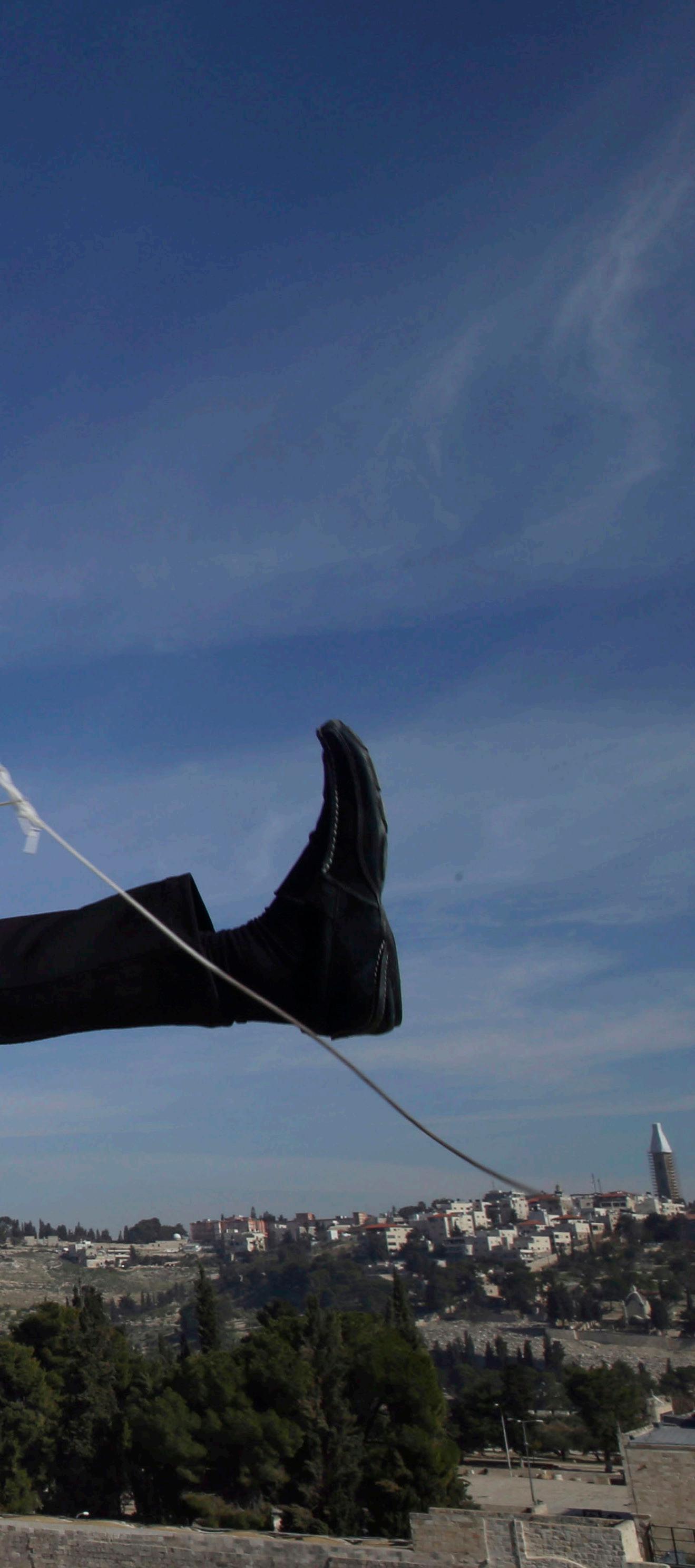
"When I see how young people in my school blossom, I am extremely grateful and know that I am making a positive contribution."
Miki Chayat
But it didn't stop there. Miki rejoined the Haredim community and went on a mission: to introduce capoeira to the world of his fellow believers. He set up a school and has been teaching ultra-Orthodox youths the tricks of the art of capoeira for fourteen years now. “It is precisely because the Haredim society is so closed that many ultra-Orthodox young people have a very difficult time. They have no access to television, internet, smartphones and computers and no opportunity to discover themselves. Their identity is completely determined by the community to which they belong. That causes problems. Not everyone is suited to studying the Torah for ten hours straight. Within the ultra-Orthodox community attention is only paid to the soul. But children also need exercise, relaxation and an outlet. Through capoeira I try to teach them a healthy lifestyle. When I see how young people in my school blossom, I am extremely grateful and I know that I am doing the right thing.”
 Miki Chayat at the American Colony Hotel, Jerusalem.
Miki Chayat at the American Colony Hotel, Jerusalem.

However, we can imagine that not every parent is pleased with the fact that their son or daughter goes to a capoeira school. “That's right. Capoeira is something new and especially the rabbis and elders are very sceptical about anything that falls outside the normal pattern. Some fear that capoeira will change the children for the worse. I try to make it clear to them that this is not the case. I talk to them and explain what capoeira is and how my school functions. It is not my intention at all to change the ultra-Orthodox community, but to add something that will make the members stronger. Usually I can convince them. Of course I am not the one who raises the children, and it is the parents who have the last word. But I know from experience that a veto does not promote communication between parents and child and that it sometimes leads the children to leave the community because they can no longer deal with the authoritarian behaviour of their parents. And that is a great pity, because when you leave the community, you are automatically rejected by your family.”
As Miki mentioned before, capoeira is more than movement. For ultra-Orthodox youths, it is even often the proverbial lifeline. “UltraOrthodox children struggle with the same problems as other children: bullying, feeling unaccepted, problems at school and even sexual abuse. At home, however, there is no room to raise such issues. In the capoeira school they feel safe and find the listening ear that they often need so badly. The school is also the only place where they can meet peers of other nationalities. Orthodox Jews from all over the world live in Jerusalem, but they do not come into contact with each other. Everyone stays within their own community with their own schools, institutes and synagogues. But in the capoeira school, everyone comes together. They get to know each other and can exchange ideas. That is enormously enriching for them. Sport builds bridges. Although the children sometimes say to each other: 'Here we are friends, but I won't greet you on the street', for fear of the parents' reaction.”
"Capoeira is the perfect sport to make young people in my ultra-Orthodox faith community physically stronger and mentally more resilient."
Miki Chayat
In addition to being director of his Abadá-Capoeira School, Miki Chayat is also the driving force behind the Stronger Association. This non-profit organisation focuses on at-risk youth from the ultra-Orthodox society in Israel to give them a helping hand through capoeira. He also supports them in acquiring education and professional skills. In addition, the organisation promotes a healthy lifestyle among the ultra-Orthodox population in Israel and coexistence between different religious and cultural sectors in the diverse country. What Miki Chayat does for his community is both admirable and commendable, though he remains humble about it. “It's my way of making a positive contribution to my community and making things better in the long run.”
Be sure to watch the Miki’s video on our website www.porschist.be

